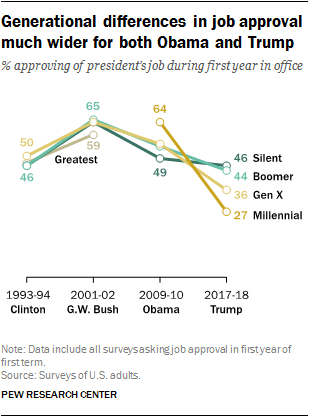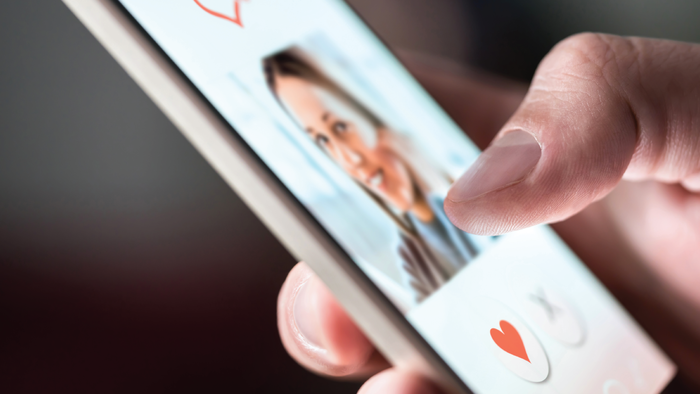
How we did this
From personal ads that began appearing in publications around the 1700s to videocassette dating services that sprang up decades ago, the platforms people use to seek out romantic partners have evolved throughout history. This evolution has continued with the rise of online dating sites and mobile apps.
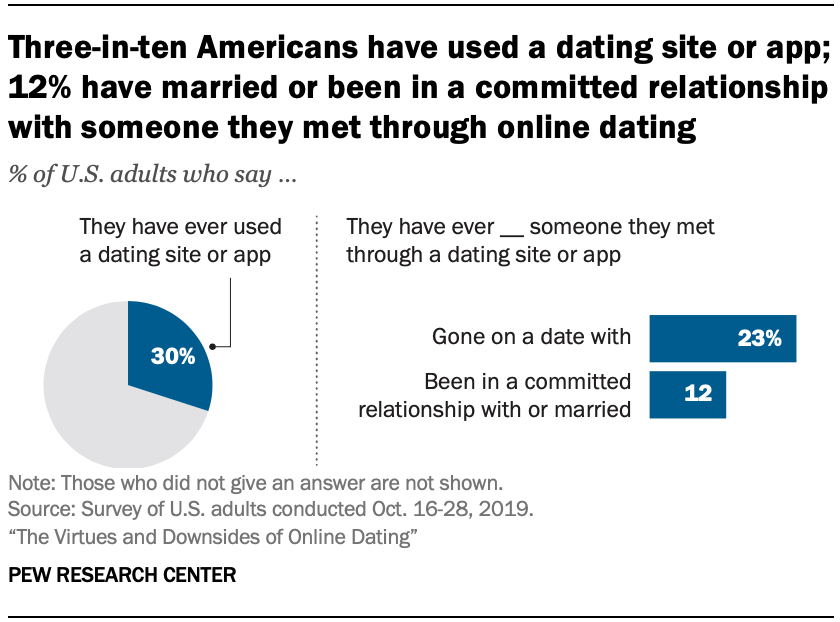 Today, three-in-ten U.S. adults say they have ever used an online dating site or app – including 11% who have done so in the past year, according to a new Pew Research Center survey conducted Oct. 16 to 28, 2019. For some Americans, these platforms have been instrumental in forging meaningful connections: 12% say they have married or been in a committed relationship with someone they first met through a dating site or app. All in all, about a quarter of Americans (23%) say they have ever gone on a date with someone they first met through a dating site or app.
Today, three-in-ten U.S. adults say they have ever used an online dating site or app – including 11% who have done so in the past year, according to a new Pew Research Center survey conducted Oct. 16 to 28, 2019. For some Americans, these platforms have been instrumental in forging meaningful connections: 12% say they have married or been in a committed relationship with someone they first met through a dating site or app. All in all, about a quarter of Americans (23%) say they have ever gone on a date with someone they first met through a dating site or app. Previous Pew Research Center studies about online dating indicate that the share of Americans who have used these platforms – as well as the share who have found a spouse or partner through them – has risen over time. In 2013, 11% of U.S. adults said they had ever used a dating site or app, while just 3% reported that they had entered into a long-term relationship or marriage with someone they first met through online dating. It is important to note that there are some changes in question wording between the Center’s 2013 and 2019 surveys, as well as differences in how these surveys were fielded.1 Even so, it is clear that websites and mobile apps are playing a larger role in the dating environment than in previous years.2
These shifting realities have sparked a broader debate about the impact of online dating on romantic relationships in America. On one side, some highlight the ease and efficiency of using these platforms to search for dates, as well as the sites’ ability to expand users’ dating options beyond their traditional social circles. Others offer a less flattering narrative about online dating – ranging from concerns about scams or harassment to the belief that these platforms facilitate superficial relationships rather than meaningful ones. This survey finds that the public is somewhat ambivalent about the overall impact of online dating. Half of Americans believe dating sites and apps have had neither a positive nor negative effect on dating and relationships, while smaller shares think its effect has either been mostly positive (22%) or mostly negative (26%).
Terminology
Throughout this report, “online dating users” and “online daters” are used interchangeably to refer to the 30% of respondents in this survey who answered yes to the following question: “Have you ever used an online dating site or dating app?”
These findings come from a nationally representative survey of 4,860 U.S. adults conducted online Oct. 16 to 28, 2019, using Pew Research Center’s American Trends Panel. The following are among the major findings.
Younger adults – as well as those who identify as lesbian, gay or bisexual – are especially likely to use online dating sites or apps
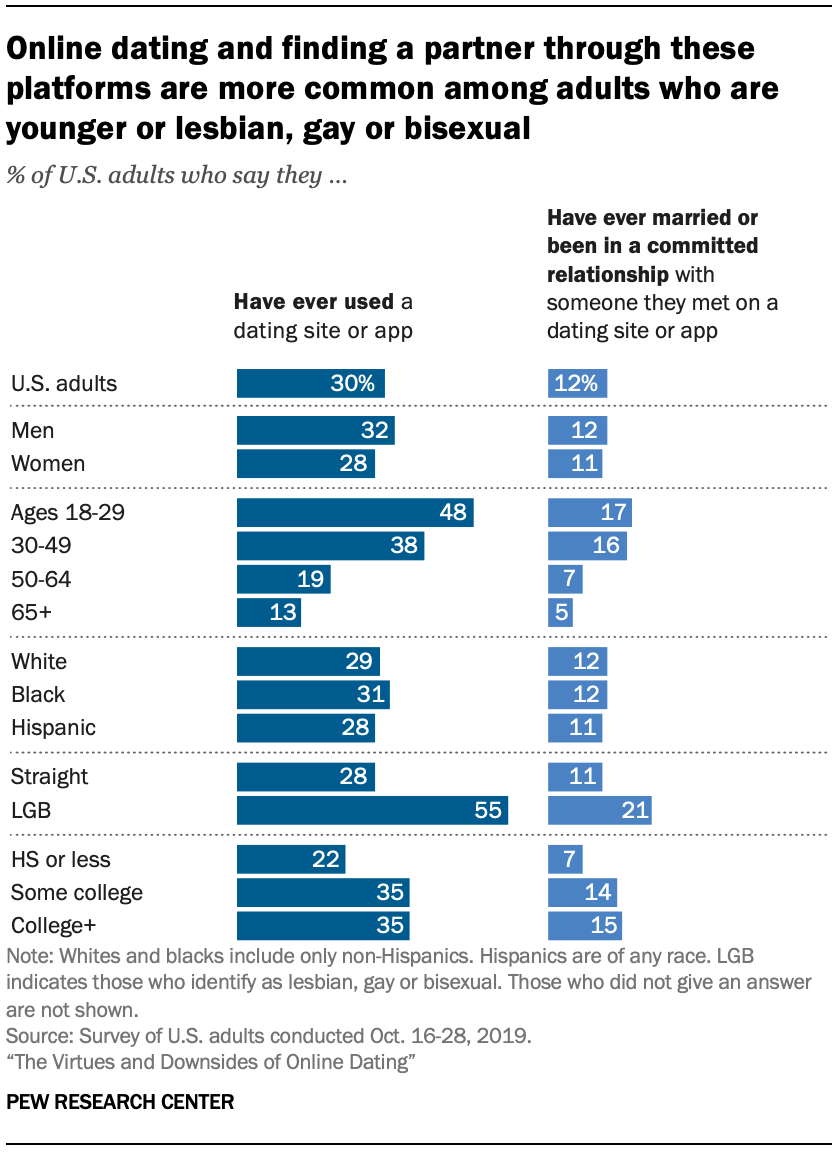 Some 30% of Americans say they have ever used an online dating site or app. Out of those who have used these platforms, 18% say they are currently using them, while an additional 17% say they are not currently doing so but have used them in the past year.
Some 30% of Americans say they have ever used an online dating site or app. Out of those who have used these platforms, 18% say they are currently using them, while an additional 17% say they are not currently doing so but have used them in the past year. Experience with online dating varies substantially by age. While 48% of 18- to 29-year-olds say they have ever used a dating site or app, that share is 38% among 30- to 49-year-olds, and it is even smaller among those ages 50 and older. Still, online dating is not completely foreign to those in their 50s or early 60s: 19% of adults ages 50 to 64 say they have used a dating site or app.
Beyond age, there also are striking differences by sexual orientation.3 LGB adults are about twice as likely as straight adults to say they have used a dating site or app (55% vs. 28%).4 And in a pattern consistent with previous Pew Research Center surveys, college graduates and those with some college experience are more likely than those with a high school education or less to say they’ve ever online dated.
There are only modest differences between men and women in their use of dating sites or apps, while white, black or Hispanic adults all are equally likely to say they have ever used these platforms.
At the same time, a small share of U.S. adults report that they found a significant other through online dating platforms. Some 12% of adults say they have married or entered into a committed relationship with someone they first met through a dating site or app. This too follows a pattern similar to that seen in overall use, with adults under the age of 50, those who are LGB or who have higher levels of educational attainment more likely to report finding a spouse or committed partner through these platforms.
A majority of online daters say they found it at least somewhat easy to come across others on dating sites or apps that they were physically attracted to or shared their interests
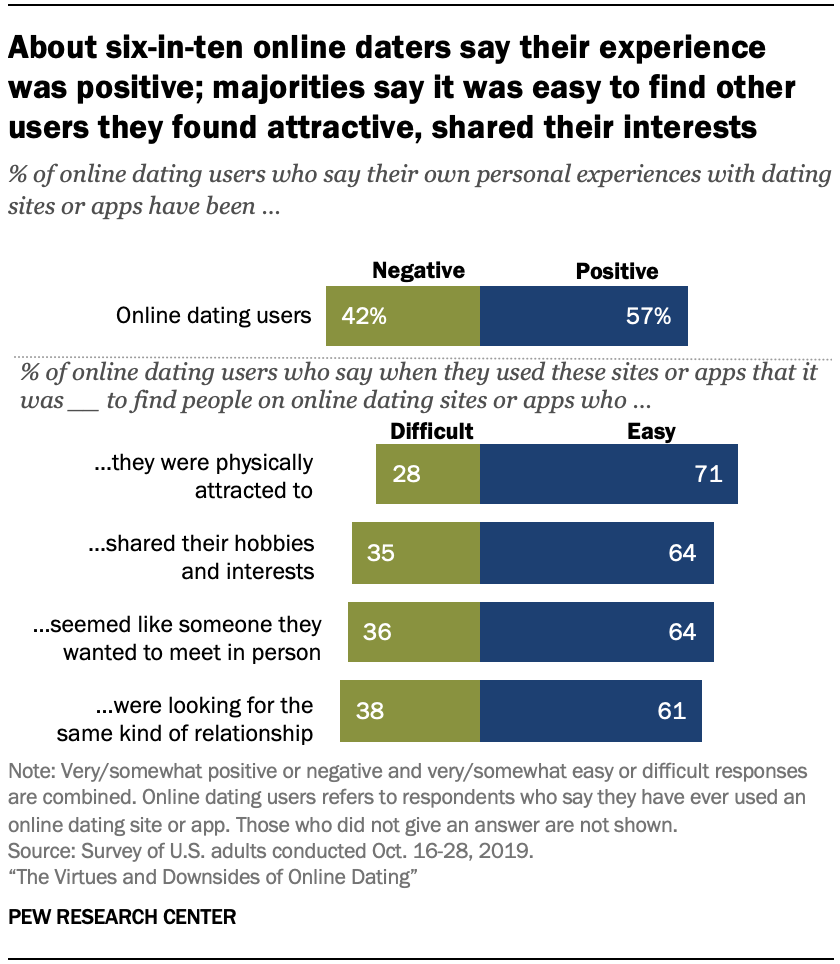 Online dating users are more likely to describe their overall experience with using dating sites or apps in positive, rather than negative, terms. Some 57% of Americans who have ever used a dating site or app say their own personal experiences with these platforms have been very or somewhat positive. Still, about four-in-ten online daters (42%) describe their personal experience with dating sites or apps as at least somewhat negative.
Online dating users are more likely to describe their overall experience with using dating sites or apps in positive, rather than negative, terms. Some 57% of Americans who have ever used a dating site or app say their own personal experiences with these platforms have been very or somewhat positive. Still, about four-in-ten online daters (42%) describe their personal experience with dating sites or apps as at least somewhat negative. For the most part, different demographic groups tend to view their online dating experiences similarly. But there are some notable exceptions. College-educated online daters, for example, are far more likely than those with a high school diploma or less to say that their own personal experience with dating sites or apps is very or somewhat positive (63% vs. 47%).
At the same time, 71% of online daters report that it was at least somewhat easy to find people on dating sites or apps that they found physically attractive, while about two-thirds say it was easy to find people who shared their hobbies or interests or seemed like someone they would want to meet in person.
While majorities across various demographic groups are more likely to describe their searches as easy, rather than difficult, there are some differences by gender. Among online daters, women are more likely than men to say it was at least somewhat difficult to find people they were physically attracted to (36% vs. 21%), while men were more likely than women to express that it was difficult to find others who shared their hobbies and interests (41% vs. 30%).
Men who have online dated in the past five years are more likely than women to feel as if they did not get enough messages from other users
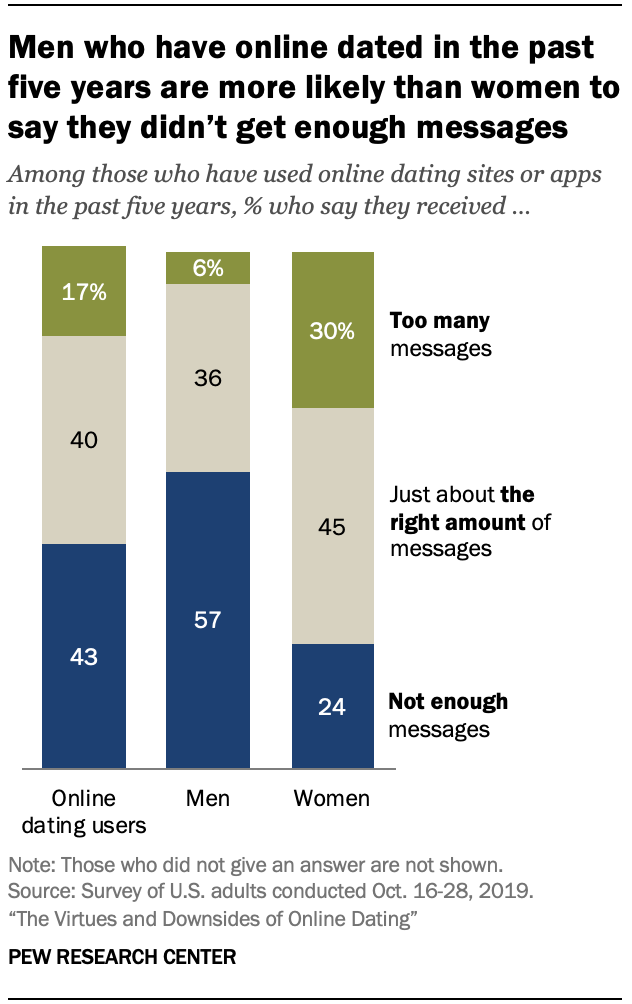 When asked if they received too many, not enough or just about the right amount of messages on dating sites or apps, 43% of Americans who online dated in the past five years say they did not receive enough messages, while 17% say they received too many messages. Another 40% think the amount of messages they received was just about right.
When asked if they received too many, not enough or just about the right amount of messages on dating sites or apps, 43% of Americans who online dated in the past five years say they did not receive enough messages, while 17% say they received too many messages. Another 40% think the amount of messages they received was just about right. There are substantial gender differences in the amount of attention online daters say they received on dating sites or apps. Men who have online dated in the past five years are far more likely than women to feel as if they did not get enough messages (57% vs. 24%). On the other hand, women who have online dated in this time period are five times as likely as men to think they were sent too many messages (30% vs. 6%).
The survey also asked online daters about their experiences with getting messages from people they were interested in. In a similar pattern, these users are more likely to report receiving too few rather than too many of these messages (54% vs. 13%). And while gender differences remain, they are far less pronounced. For example, 61% of men who have online dated in the past five years say they did not receive enough messages from people they were interested in, compared with 44% of women who say this.
Roughly seven-in-ten online daters think people lying to appear more desirable is a very common occurrence on online dating platforms
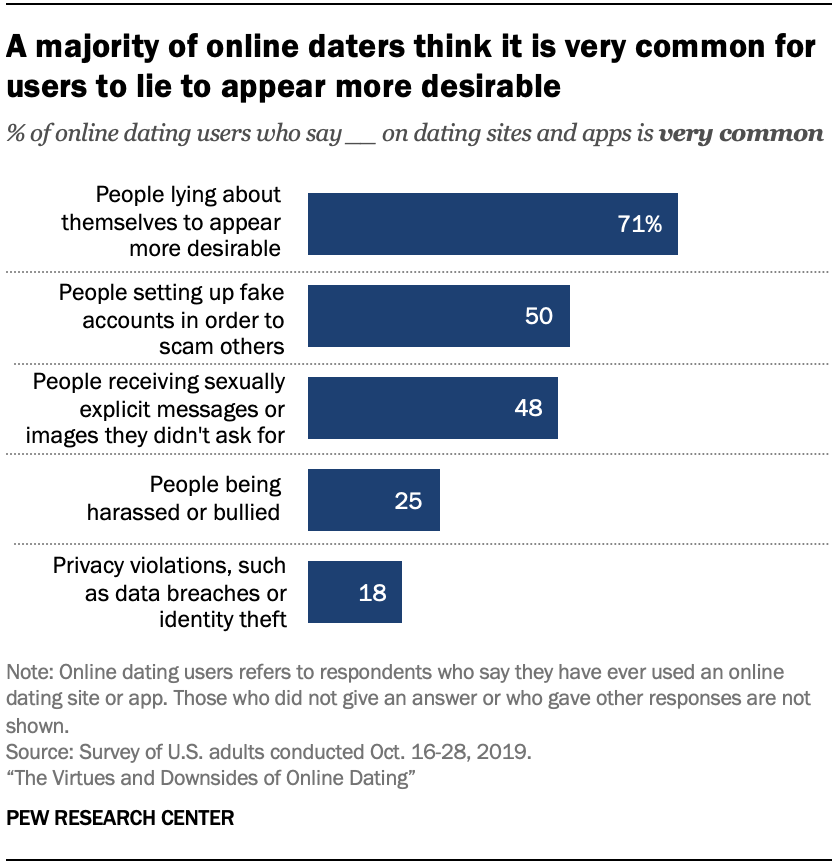 Online daters widely believe that dishonesty is a pervasive issue on these platforms. A clear majority of online daters (71%) say it is very common for people on these platforms to lie about themselves to appear more desirable, while another 25% think it is somewhat common. Only 3% of online daters think this is not a common occurrence on dating platforms.
Online daters widely believe that dishonesty is a pervasive issue on these platforms. A clear majority of online daters (71%) say it is very common for people on these platforms to lie about themselves to appear more desirable, while another 25% think it is somewhat common. Only 3% of online daters think this is not a common occurrence on dating platforms. Smaller, but still substantial shares, of online daters believe people setting up fake accounts in order to scam others (50%) or people receiving sexually explicit messages or images they did not ask for (48%) are very common on dating sites and apps. By contrast, online daters are less likely to think harassment or bullying, and privacy violations, such as data breaches or identify theft, are very common occurrences on these platforms.
Some users – especially younger women – report being the target of rude or harassing behavior while on these platforms
Some experts contend that the open nature of online dating — that is, the fact that many users are strangers to one another — has created a less civil dating environment and therefore makes it difficult to hold people accountable for their behavior. This survey finds that a notable share of online daters have been subjected to some form of harassment measured in this survey.
Roughly three-in-ten or more online dating users say someone through a dating site or app continued to contact them after they said they were not interested (37%), sent them a sexually explicit message or image they didn’t ask for (35%) or called them an offensive name (28%). Fewer online daters say someone via a dating site or app has threatened to physically harm them.
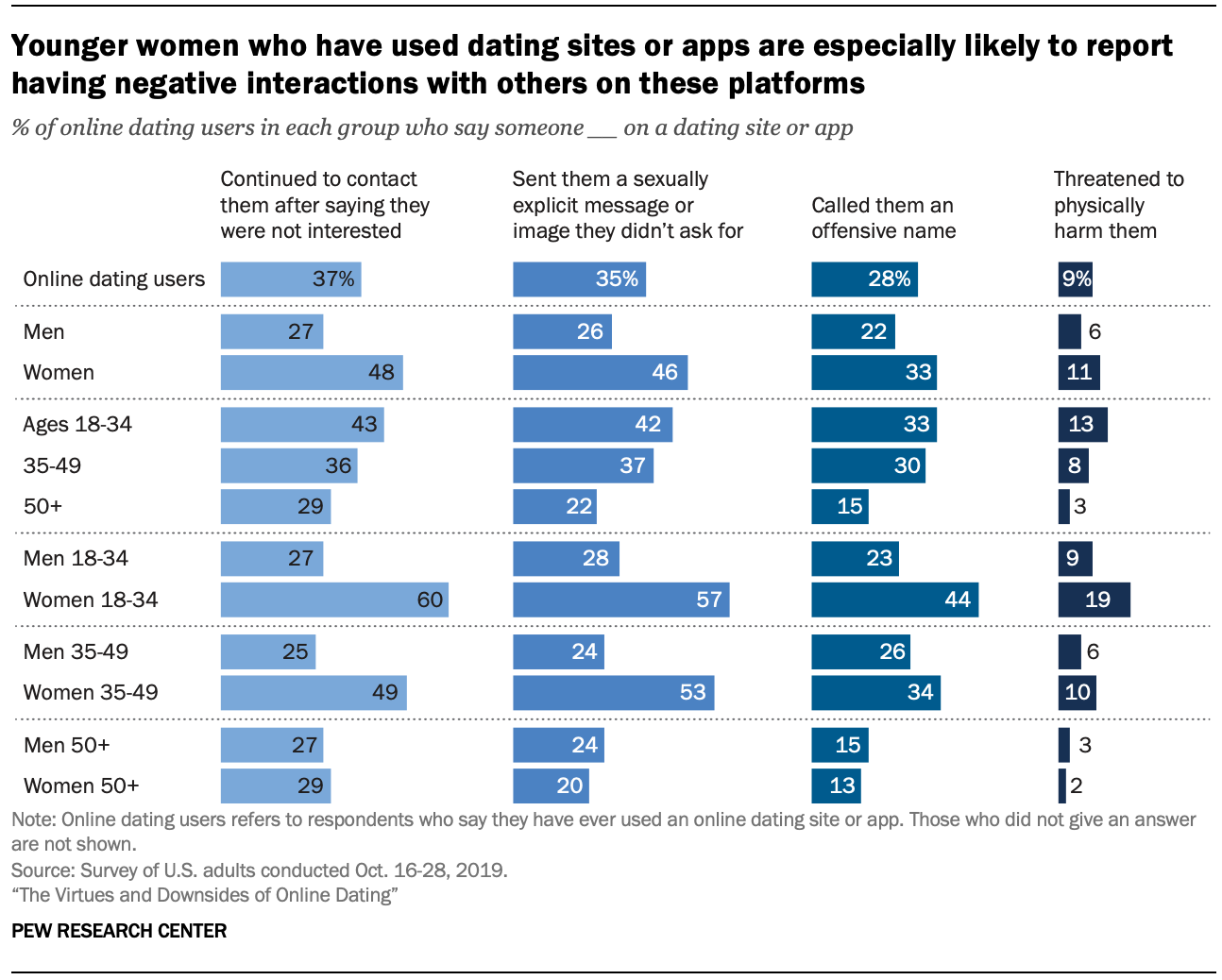
Younger women are particularly likely to encounter each of these behaviors. Six-in-ten female online dating users ages 18 to 34 say someone via a dating site or app continued to contact them after they said they were not interested, while 57% report that another user has sent them a sexually explicit message or image they didn’t ask for. Other negative interactions are more violent in nature: 19% of younger female users say someone on a dating site or app has threatened to physically harm them – roughly twice the rate of men in the same age range who say this.
The likelihood of encountering these kinds of behaviors on dating platforms also varies by sexual orientation. Fully 56% of LGB users say someone on a dating site or app has sent them a sexually explicit message or image they didn’t ask for, compared with about one-third of straight users (32%). LGB users are also more likely than straight users to say someone on a dating site or app continued to contact them after they told them they were not interested, called them an offensive name or threatened to physically harm them.
Online dating is not universally seen as a safe way to meet someone
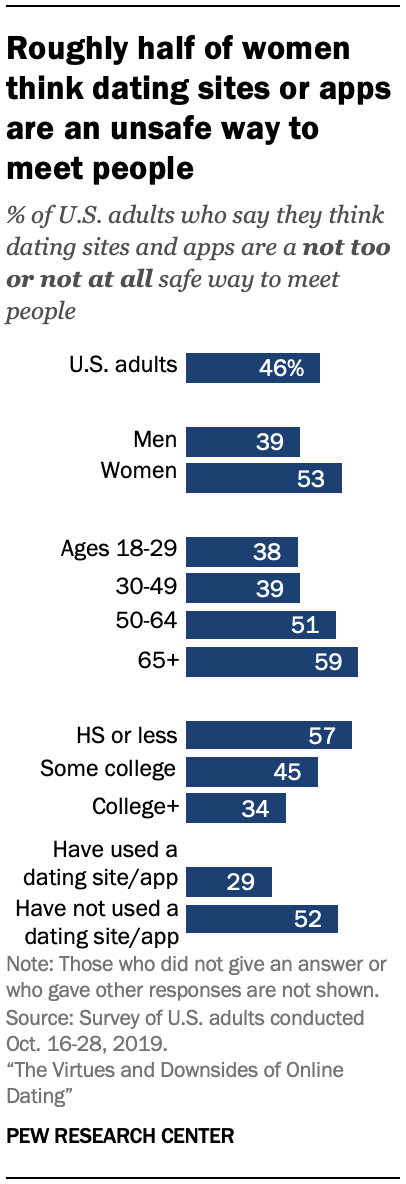 The creators of online dating sites and apps have at times struggled with the perception that these sites could facilitate troubling – or even dangerous – encounters. And although there is some evidence that much of the stigma surrounding these sites has diminished over time, close to half of Americans still find the prospect of meeting someone through a dating site unsafe.
The creators of online dating sites and apps have at times struggled with the perception that these sites could facilitate troubling – or even dangerous – encounters. And although there is some evidence that much of the stigma surrounding these sites has diminished over time, close to half of Americans still find the prospect of meeting someone through a dating site unsafe. Some 53% of Americans overall (including those who have and have not online dated) agree that dating sites and apps are a very or somewhat safe way to meet people, while a somewhat smaller share (46%) believe these platforms are a not too or not at all safe way of meeting people.
Americans who have never used a dating site or app are particularly skeptical about the safety of online dating. Roughly half of adults who have never used a dating or app (52%) believe that these platforms are a not too or not at all safe way to meet others, compared with 29% of those who have online dated.
There are some groups who are particularly wary of the idea of meeting someone through dating platforms. Women are more inclined than men to believe that dating sites and apps are not a safe way to meet someone (53% vs. 39%).
Age and education are also linked to differing attitudes about the topic. For example, 59% of Americans ages 65 and older say meeting someone this way is not safe, compared with 51% of those ages 50 to 64 and 39% among adults under the age of 50. Those who have a high school education or less are especially likely to say that dating sites and apps are not a safe way to meet people, compared with those who have some college experience or who have at bachelor’s or advanced degree. These patterns are consistent regardless of each group’s own personal experience with using dating sites or apps.
Pluralities think online dating has neither helped nor harmed dating and relationships and that relationships that start online are just as successful as those that begin offline
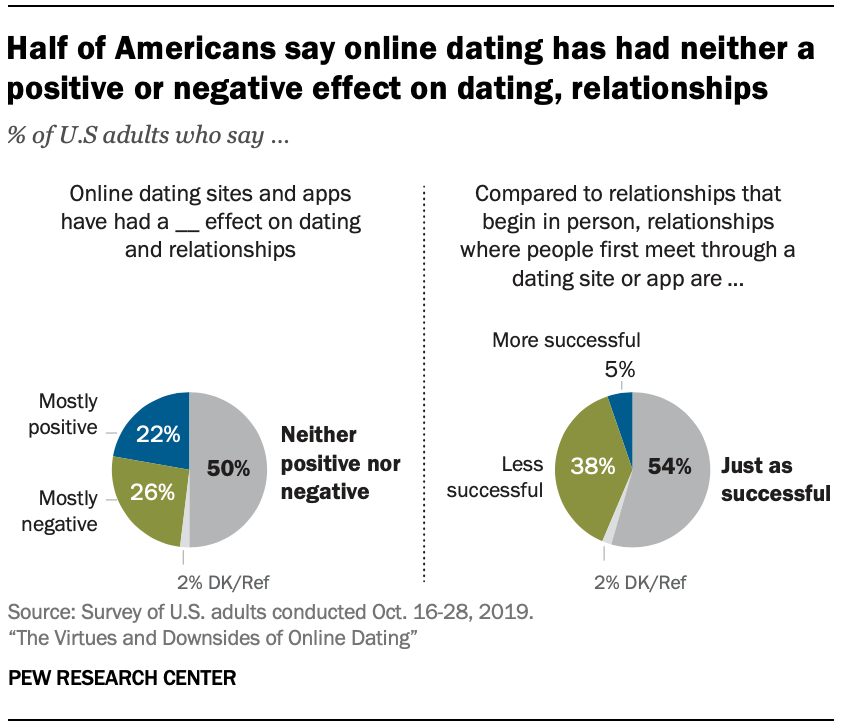 Americans – regardless of whether they have personally used online dating services or not – also weighed in on the virtues and pitfalls of online dating. Some 22% of Americans say online dating sites and apps have had a mostly positive effect on dating and relationships, while a similar proportion (26%) believe their effect has been mostly negative. Still, the largest share of adults – 50% – say online dating has had neither a positive nor negative effect on dating and relationships.
Americans – regardless of whether they have personally used online dating services or not – also weighed in on the virtues and pitfalls of online dating. Some 22% of Americans say online dating sites and apps have had a mostly positive effect on dating and relationships, while a similar proportion (26%) believe their effect has been mostly negative. Still, the largest share of adults – 50% – say online dating has had neither a positive nor negative effect on dating and relationships. Respondents who say online dating’s effect has been mostly positive or mostly negative were asked to explain in their own words why they felt this way. Some of the most common reasons provided by those who believe online dating has had a positive effect focus on its ability to expand people’s dating pools and to allow people to evaluate someone before agreeing to meet in person. These users also believe dating sites and apps generally make the process of dating easier. On the other hand, people who said online dating has had a mostly negative effect most commonly cite dishonesty and the idea that users misrepresent themselves.
Pluralities also believe that whether a couple met online or in person has little effect on the success of their relationship. Just over half of Americans (54%) say that relationships where couples meet through a dating site or app are just as successful as those that begin in person, 38% believe these relationships are less successful, while 5% deem them more successful.
Public attitudes about the impact or success of online dating differ between those who have used dating platforms and those who have not. While 29% of online dating users say dating sites and apps have had a mostly positive effect on dating and relationships, that share is 21% among non-users. People who have ever used a dating site or app also have a more positive assessment of relationships forged online. Some 62% of online daters believe relationships where people first met through a dating site or app are just as successful as those that began in person, compared with 52% of those who never online dated.
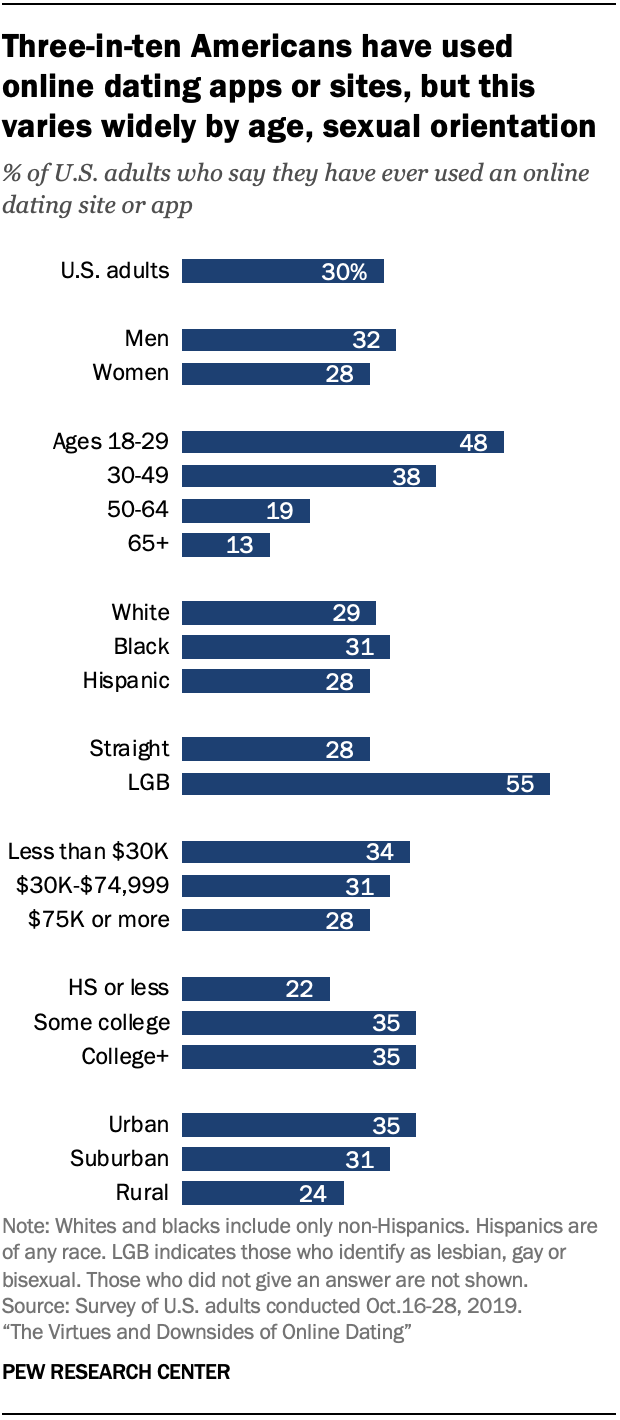 Digital
technology permeates almost every facet of society – from how people
get news and information to the way they shop or apply for jobs and even
how they seek romantic partners. Since online dating sites’ humble beginnings in the mid-1990s, these platforms have risen to become a multibillion-dollar industry that serves customers around the world.
Digital
technology permeates almost every facet of society – from how people
get news and information to the way they shop or apply for jobs and even
how they seek romantic partners. Since online dating sites’ humble beginnings in the mid-1990s, these platforms have risen to become a multibillion-dollar industry that serves customers around the world.Today, 30% of adults say they have ever used a dating site or app, but people’s experiences with online dating vary substantially across demographic groups.
To begin with, adults under the age of 30 are particularly likely to say they have used these dating platforms. Roughly half of 18- to 29-year-olds (48%) say they have ever used a dating site or app, compared with 38% of those ages 30 to 49, and 16% of those ages 50 and older. At the same time, there are significant differences in online dating experience by sexual orientation. More than half of LGB Americans (55%) report ever using these platforms, compared with 28% of those who are straight.
Use of online dating platforms also varies substantially by current marital status. Fully 52% of Americans who have never been married say they have ever used a dating site or app, compared with around one-third of those who are divorced, separated or widowed (35%) and just 21% of those who are married or living with a partner.
Although less pronounced, experiences with online dating also differ by educational attainment and community type. For example, 35% of those who have at least a bachelor’s degree have ever used a dating site or app, compared with 22% of those with a high school education or less. Additionally, those living in urban or suburban communities are more likely than those living in rural areas to say they have used these platforms.
Roughly one-in-five online dating users say they are currently using these platforms
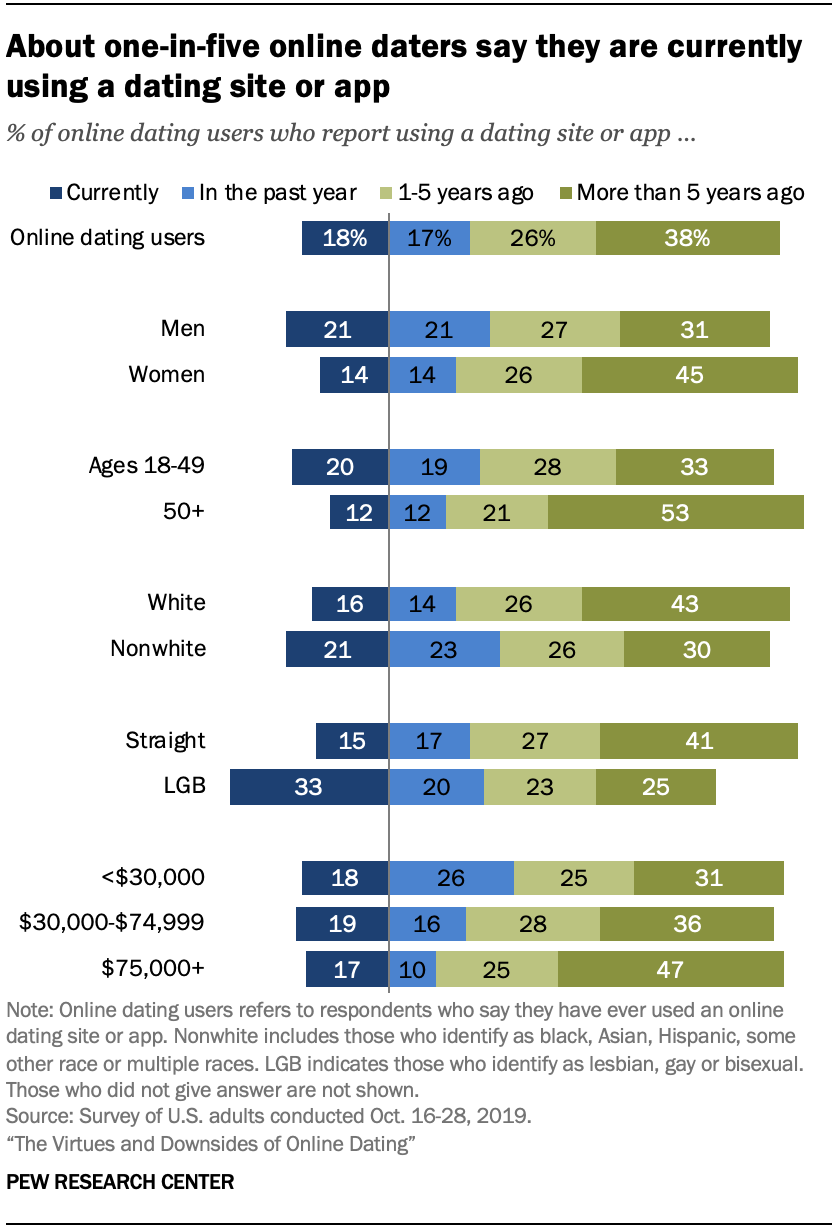 Some
18% of Americans who have ever used a dating site or app say they are
currently using these platforms, while another 17% report that they are
not currently doing so but have in the past year. Still, a majority of
people who have ever used these platforms report that the last time they
did so was either between one and five years ago (26%) or more than
five years ago (38%).
Some
18% of Americans who have ever used a dating site or app say they are
currently using these platforms, while another 17% report that they are
not currently doing so but have in the past year. Still, a majority of
people who have ever used these platforms report that the last time they
did so was either between one and five years ago (26%) or more than
five years ago (38%).People who identify as lesbian, gay or bisexual are particularly likely to be current users of these platforms. One-in-three LGB Americans who have online dated are currently using a dating site or app, compared with 15% of straight users.
At the same time, online dating users ages 18 to 49 are more likely than those ages 50 and older to say they are currently using these platforms (20% vs. 12%), while men who say they’ve used these platforms are more likely than women to be current users of dating sites or apps (21% vs. 14%).
39% of online daters – and 12% of Americans overall – have married or been in a committed relationship with someone they first met through a dating site or app
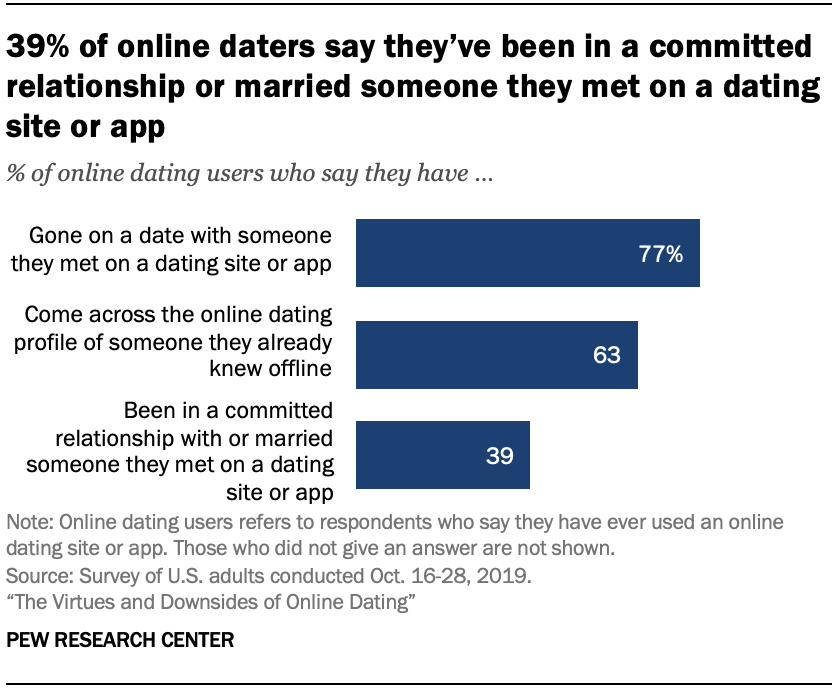 Fully
77% of online dating users – and 23% of Americans overall – say they
have gone on a date with someone they first met through a dating app or
website. Interestingly, about one-in-four Americans who have used a
dating site or app (23%) say they have never been on a date with someone
they met through these platforms.
Fully
77% of online dating users – and 23% of Americans overall – say they
have gone on a date with someone they first met through a dating app or
website. Interestingly, about one-in-four Americans who have used a
dating site or app (23%) say they have never been on a date with someone
they met through these platforms.And while a majority of online daters have never forged a committed relationship with someone they first encountered through these platforms, 39% of online dating users (representing 12% of all U.S. adults) say they have been in a committed relationship or married someone they met on a dating site or app.
It also is fairly common for online daters to encounter people on these platforms that they already know: 63% of online daters (or 19% of all U.S. adults) say they have come across the profile of someone they already know offline.
Dating and its outcomes tend to vary by online daters’ level of education
Not only are those who have attended college more likely to use dating sites or apps compared with those who have less formal education, they also are more likely to have met or formed a committed relationship with the help of these sites.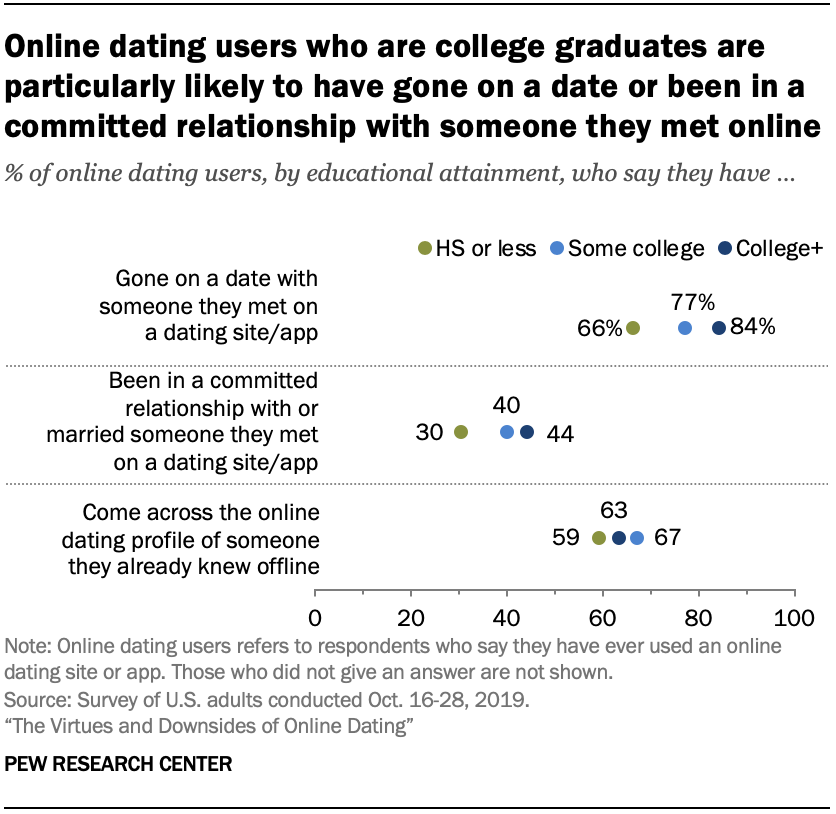 Majorities
across educational levels say they have gone on a date with someone
they met through online dating, but these shares are higher among those
with a college degree. Fully 84% of online dating users with at least a
bachelor’s degree report going out with someone they met on a dating
site or app, compared with 77% of those with some college experience,
and 66% of those with a high school diploma or less.
Majorities
across educational levels say they have gone on a date with someone
they met through online dating, but these shares are higher among those
with a college degree. Fully 84% of online dating users with at least a
bachelor’s degree report going out with someone they met on a dating
site or app, compared with 77% of those with some college experience,
and 66% of those with a high school diploma or less.College graduates and those with some college experience who used these platforms also are more likely than those with a high school education or less to say they have been in a committed relationship or married someone they met through an online dating site or app. These educational differences are similar when looking at just online daters ages 25 and older.
Users of online dating platforms experience both positive – and negative – aspects of courtship on the web
Over the past two decades,
the internet and smartphones have transformed where, when and how
people meet potential romantic partners. But, as many aspects of dating
have migrated online, how do online daters themselves feel about their
time spent using these platforms?
Overall, online daters are more likely to rate their experiences in positive rather than negative terms, and majorities of these users say that it is was easy to find others who shared their interests or wanted to meet in person. But users also describe a more troubling and frustrating side of online dating, including their own encounters with harassing behaviors on these platforms.
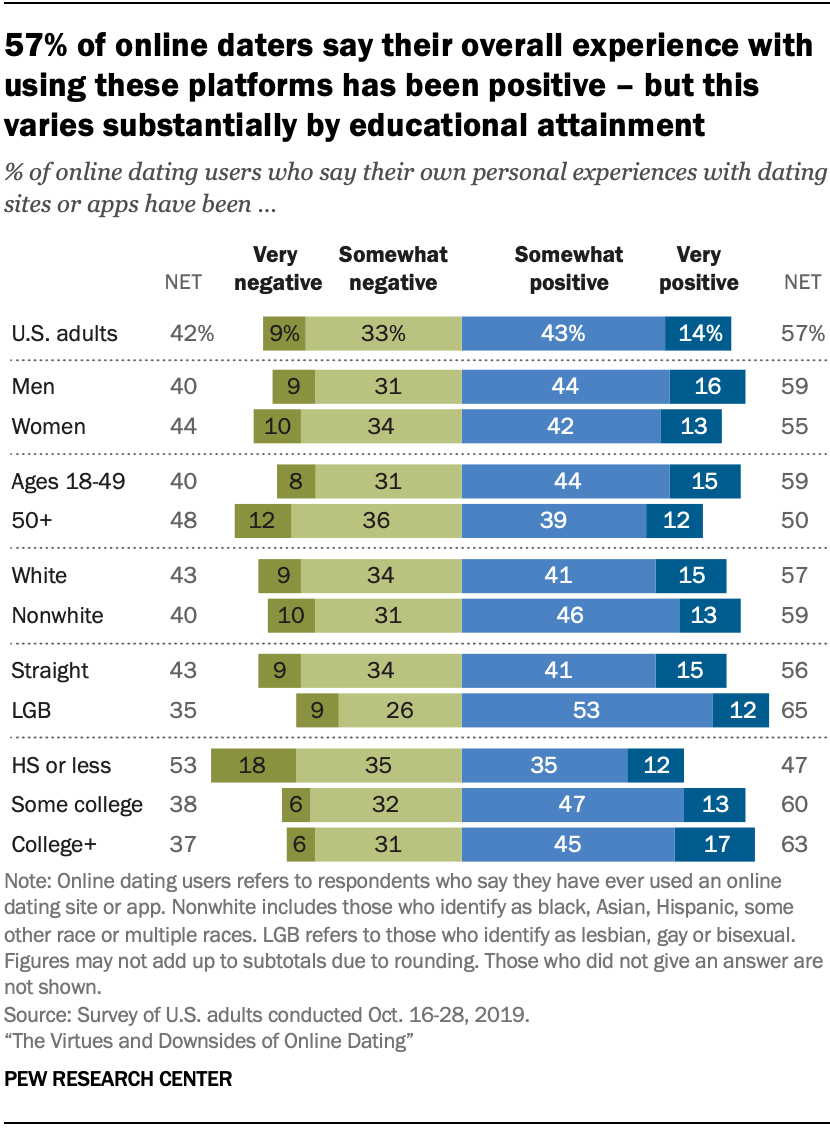 Some
57% of Americans who have ever used an online dating site or app say
their own personal experiences with these platforms have been very (14%)
or somewhat (43%) positive. Smaller shares of users – though still
about four-in-ten – describe their time with online dating as at least
somewhat negative, including 9% who say it was a very negative.
Some
57% of Americans who have ever used an online dating site or app say
their own personal experiences with these platforms have been very (14%)
or somewhat (43%) positive. Smaller shares of users – though still
about four-in-ten – describe their time with online dating as at least
somewhat negative, including 9% who say it was a very negative.
The way people assess their online dating experiences varies widely by socioeconomic factors. Fully 63% of online daters with a bachelor’s or advanced degree say their experience has been very or somewhat positive, compared with 47% among those who have a high school diploma or less. A similar pattern ties to users’ income: Online dating users whose annual family income is $75,000 or more a year are far more likely than those whose yearly family income falls below $30,000 to describe their experience as at least somewhat positive (70% vs. 44%).
By comparison, there are more modest differences by sexual orientation or age. LGB users are more likely than straight users to describe their own experience with dating sites or apps as very or somewhat positive (65% vs. 56%), while users ages 18 to 49 are more likely than those ages 50 and older to say their online dating experience has been at least somewhat positive (59% vs. 50%). By contrast, the way online daters rate their overall experience does not statistically vary by gender or race and ethnicity.
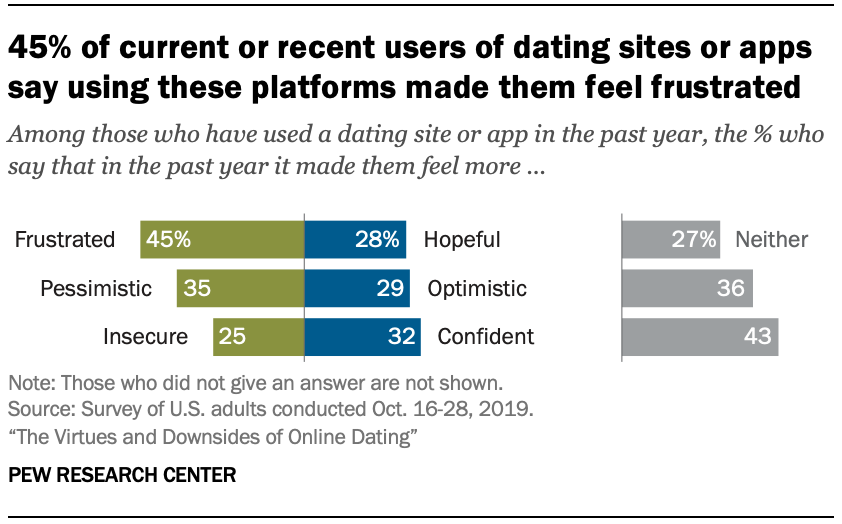 To
better understand users’ experiences, the survey presented those who
have used online dating sites or apps within the past year with three
pairs of words and asked them to choose the sentiment that most closely
matched how they felt when using these platforms. Larger shares of
Americans who are currently using dating sites or apps or who have done
so in the past year say the experience left them feeling more frustrated
(45%) than hopeful (28%). Another 27% of these users say they felt
neither hopeful nor frustrated.
To
better understand users’ experiences, the survey presented those who
have used online dating sites or apps within the past year with three
pairs of words and asked them to choose the sentiment that most closely
matched how they felt when using these platforms. Larger shares of
Americans who are currently using dating sites or apps or who have done
so in the past year say the experience left them feeling more frustrated
(45%) than hopeful (28%). Another 27% of these users say they felt
neither hopeful nor frustrated.
Other sentiments are more evenly balanced between positive and negative feelings. Some 35% of current or recent users say that in the past year online dating has made them feel more pessimistic, while 29% say these platforms left them feeling more optimistic. At the same time, 32% of current or recent online daters report that in the past year, dating sites or apps made them feel more confident, while 25% say dating sites or apps made them feel more insecure. Still, for each of these pairs of words, nearly four-in-ten or more of these users say that neither of the emotions offered reflects how they felt when using a dating site or app in the past year.
Online dating users across most demographic groups report similar emotions while using these platforms, but there are some differences by race and ethnicity. Among those who have used a dating site or app in the past year, white users are more likely than nonwhite users to say that these platforms have made them feel more frustrated (53% vs. 36%) or more pessimistic (40% vs. 29%).5
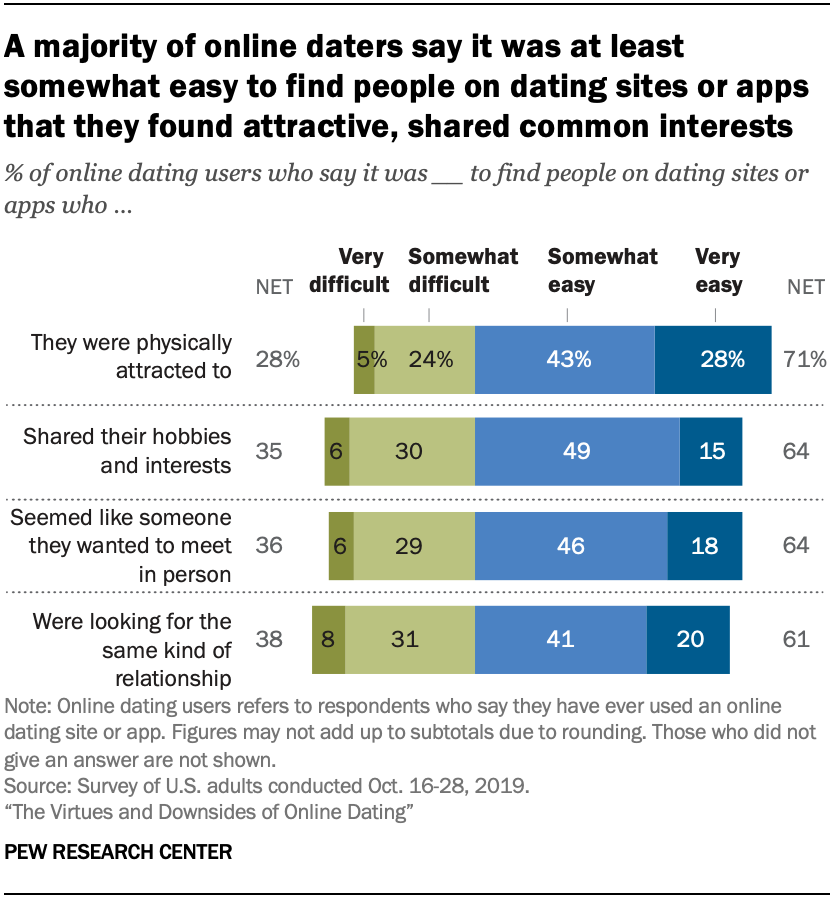 There have been numerous accounts
detailing some of the struggles of online dating – including the
difficulty that users may encounter when trying to find someone
compatible. Overall, online daters are more likely to say that finding
desirable or like-minded people was an easy rather than difficult
endeavor, but there are some groups who find these aspects of online
dating more daunting.
There have been numerous accounts
detailing some of the struggles of online dating – including the
difficulty that users may encounter when trying to find someone
compatible. Overall, online daters are more likely to say that finding
desirable or like-minded people was an easy rather than difficult
endeavor, but there are some groups who find these aspects of online
dating more daunting.
Fully 71% of Americans who have ever used a dating site or app say it was at least somewhat easy to find people on these platforms that they were physically attracted to, including 28% who say that this was a very easy task for them. A majority of online daters also said it was very or somewhat easy to find people who shared their hobbies and interests (64%), seemed like someone they would want to meet in person (64%) or were looking for the same kind of relationship as them (61%).
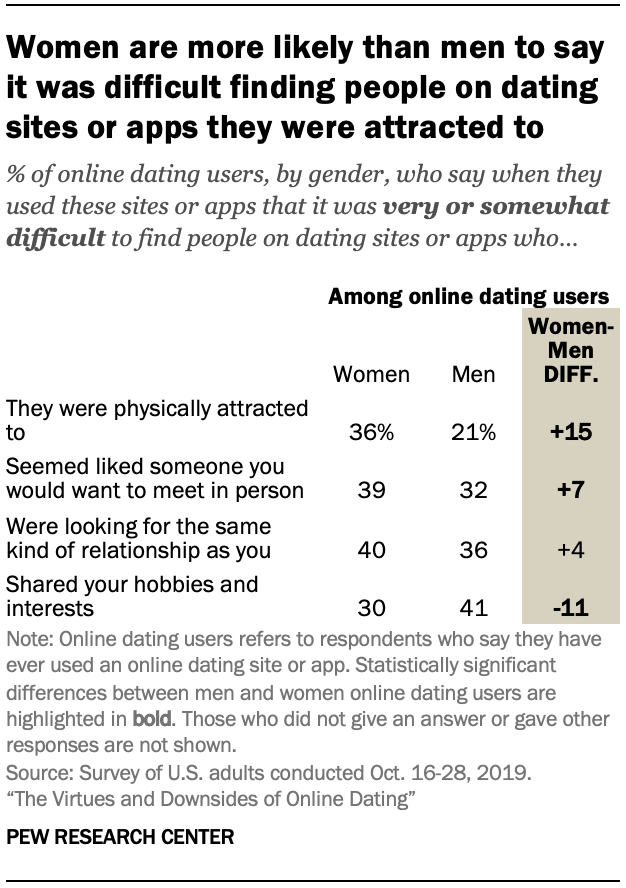 Online
daters’ assessments of how hard or easy it was to find compatible users
varies by gender. Women who have ever used a dating site or app are
more likely than men to say they have found it very or somewhat
difficult to find people that they were physical attracted to (36% vs.
21%) or seemed like someone they would want to meet in person (39% vs.
32%). On the other hand, 41% of male users say they found it at least
somewhat difficult to find people who shared their hobbies and
interests, compared with three-in-ten female users.
Online
daters’ assessments of how hard or easy it was to find compatible users
varies by gender. Women who have ever used a dating site or app are
more likely than men to say they have found it very or somewhat
difficult to find people that they were physical attracted to (36% vs.
21%) or seemed like someone they would want to meet in person (39% vs.
32%). On the other hand, 41% of male users say they found it at least
somewhat difficult to find people who shared their hobbies and
interests, compared with three-in-ten female users.
There are some educational differences as well. Online daters who have a high school education or less, for example, are more likely than those with a bachelor’s or advanced degree to say that it was very or somewhat difficult to find people who were looking for the same kind of relationship as them (45% vs. 32%) or who shared their hobbies or interests (39% vs. 30%).
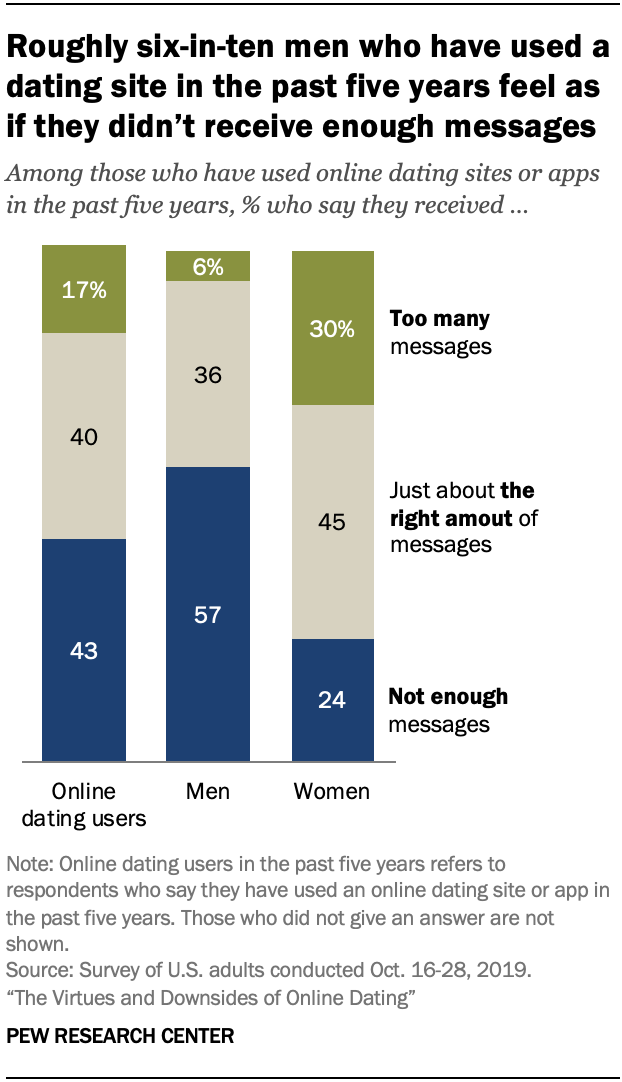 But
there are stark gender differences in the amount of attention users
report receiving. Some 57% of men who have online dated in the past five
years report that they did not receive enough messages, while just 6%
state they received too many messages. By contrast, women who have used
dating sites or apps in this time period are five times as likely as men
to report they were sent too many messages (30% vs. 6%) and are far
less likely than men to say they did not receive enough messages (24%
express this view).
But
there are stark gender differences in the amount of attention users
report receiving. Some 57% of men who have online dated in the past five
years report that they did not receive enough messages, while just 6%
state they received too many messages. By contrast, women who have used
dating sites or apps in this time period are five times as likely as men
to report they were sent too many messages (30% vs. 6%) and are far
less likely than men to say they did not receive enough messages (24%
express this view).
The survey also asked online daters about their experiences with getting messages from people they were interested in. Similarly, these users are more likely to report receiving too few rather than too many of these messages (54% vs. 13%). And while gender differences remain, they are less pronounced. For example, 61% of men who have online dated in the past five years say they did not receive enough messages from people they were interested in, compared with 44% of women who say this.
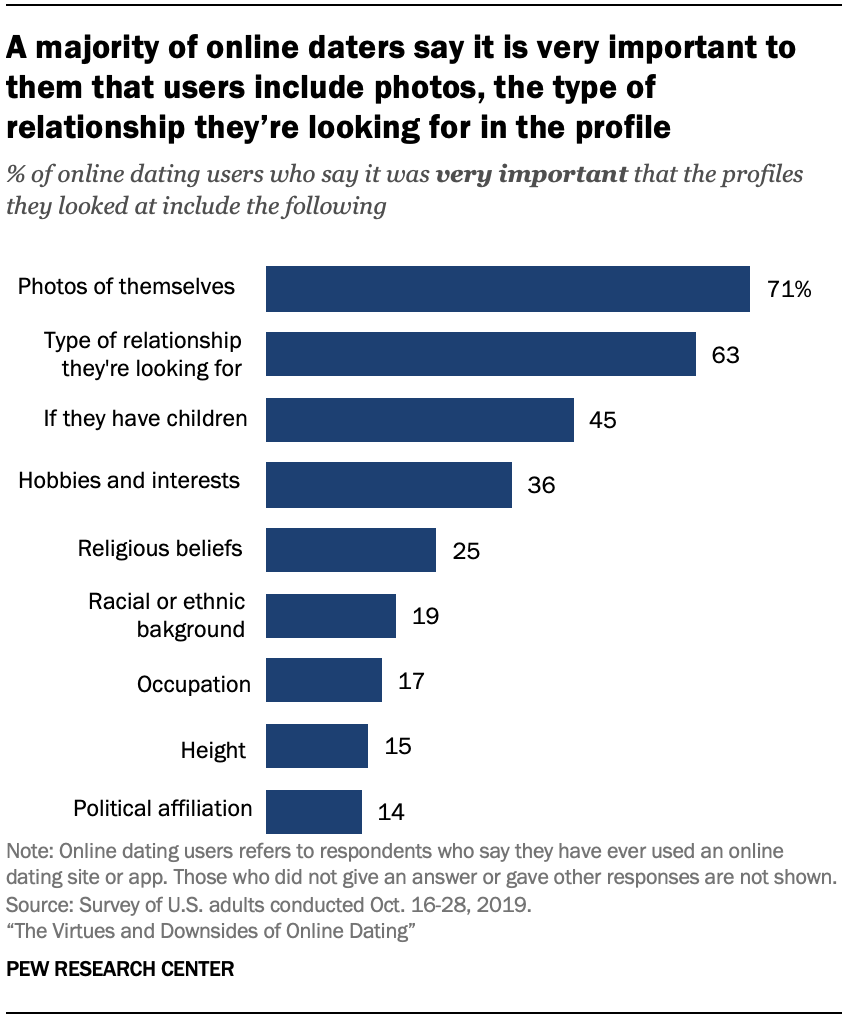 Online
daters find it especially important to be able to view someone’s photo.
Fully 71% of users say it was very important to them that the profiles
they looked at included the other user’s photo.
Online
daters find it especially important to be able to view someone’s photo.
Fully 71% of users say it was very important to them that the profiles
they looked at included the other user’s photo.
A majority of online dating users also felt it was necessary to gauge other users’ intentions: 63% say it was very important that the profiles they looked through included the type of relationship the other person was looking for.
Additionally, 45% of users say it was very important that profiles included whether the person had any children; 36% say this about hobbies and interests; and 25% feel this way about religious beliefs.
Smaller shares of users consider a person’s racial or ethnic background, occupation, height or political affiliation to be very important information to discover when looking through online dating profiles.
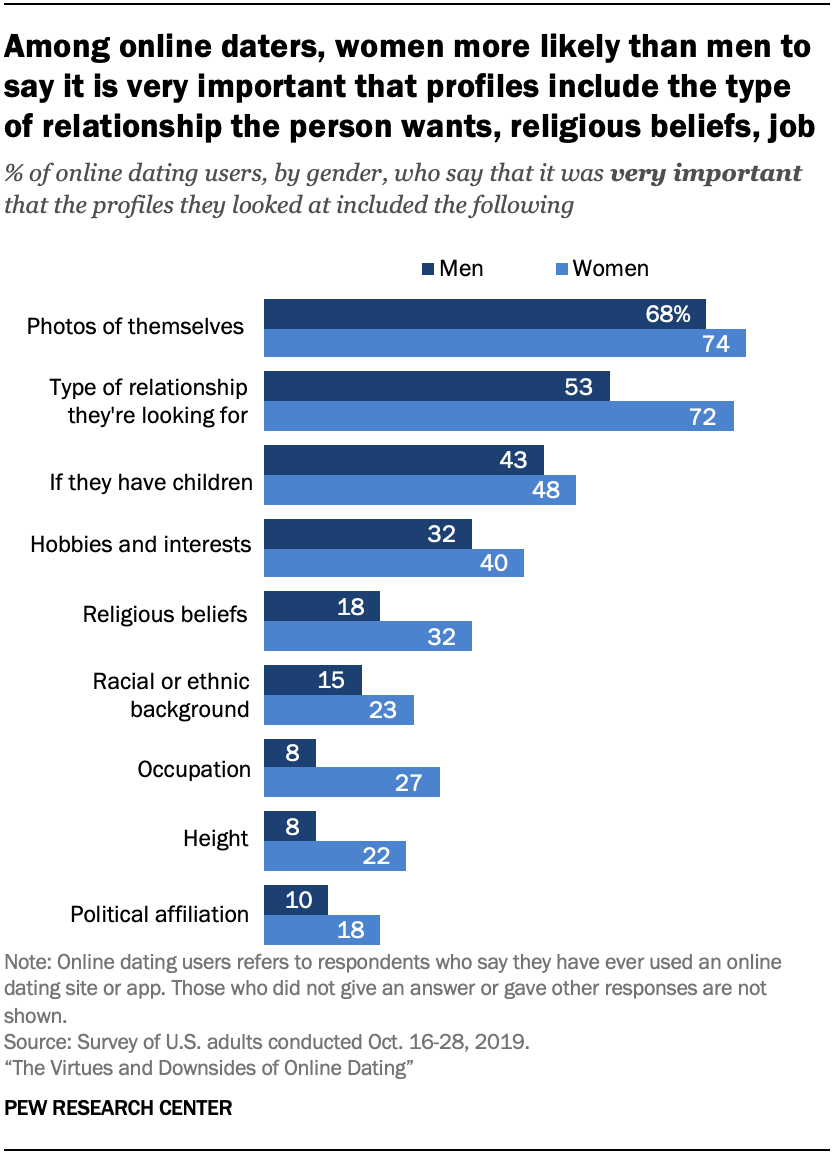 Across
several measures, women are more likely than men to describe certain
information as essential to glean from someone’s profile. Roughly
seven-in-ten female users (72%) say that it was very important to them
that the profiles they looked at included the type of relationship the
person was looking for, while about half of male users say this (53%).
Among online daters, women also are more likely than men to say that it
was very important to them that the profiles included a person’s
religious beliefs (32% vs. 18%), occupation (27% vs. 8%) or height (22%
vs. 8%).
Across
several measures, women are more likely than men to describe certain
information as essential to glean from someone’s profile. Roughly
seven-in-ten female users (72%) say that it was very important to them
that the profiles they looked at included the type of relationship the
person was looking for, while about half of male users say this (53%).
Among online daters, women also are more likely than men to say that it
was very important to them that the profiles included a person’s
religious beliefs (32% vs. 18%), occupation (27% vs. 8%) or height (22%
vs. 8%).
Other gender differences – such as the importance of users including in their profiles hobbies and interests, racial or ethnic background, or political affiliation – are more modest.
The level of importance that users place on certain content also varies by age. Online dating users ages 50 and older are more likely than users ages 18 to 49 to say that it is very important that the profiles they looked at included the person’s race or ethnicity (26% vs. 16%) or their political affiliation (21% vs. 12%). Younger users, on the other hand, are more likely than older users to say that it was very important to them that profiles they came across included whether the person had children (48% vs. 37%).
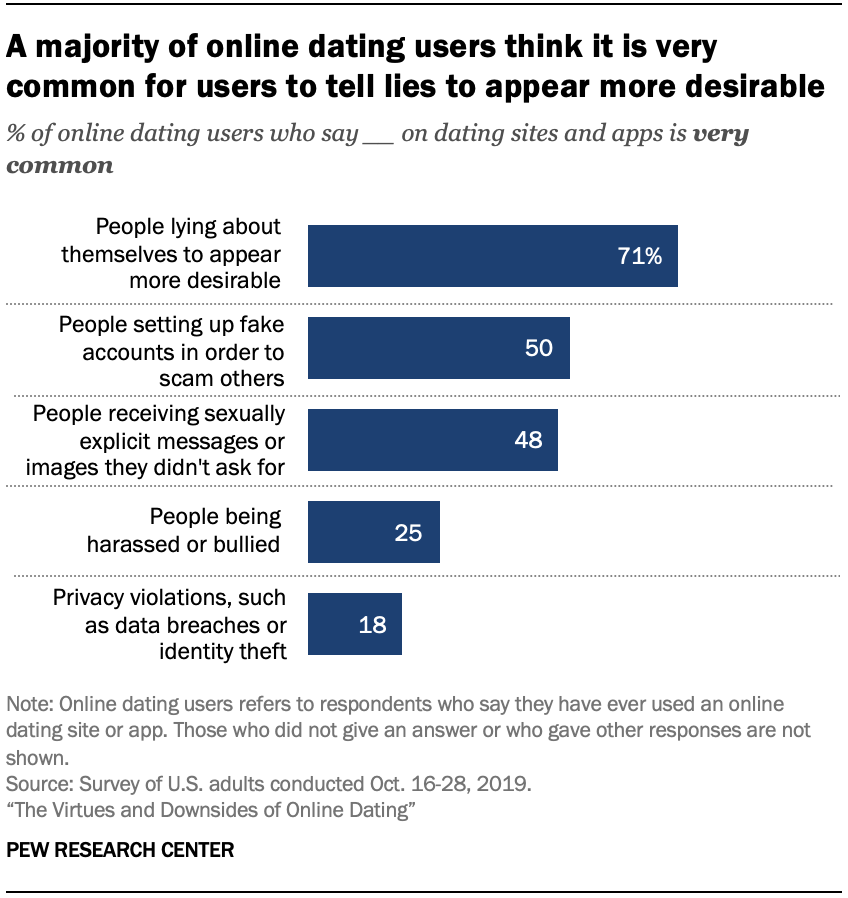 Indeed,
a majority of users characterize lying as a prevalent feature of the
online dating environment. Fully 71% of adults who have used an online
dating site or app say it is very common for people on these platforms
to lie about themselves to appear more desirable.
Indeed,
a majority of users characterize lying as a prevalent feature of the
online dating environment. Fully 71% of adults who have used an online
dating site or app say it is very common for people on these platforms
to lie about themselves to appear more desirable.
Smaller shares – though still about half of all users – believe that it is very common for people on dating sites and apps to set up fake accounts in order to scam others (50%) or for people to receive sexually explicit messages or images they did not ask for (48%). Fewer users believe that people being harassed or bullied (25%) or data privacy violations (18%) are very common occurrences on online dating sites or apps.
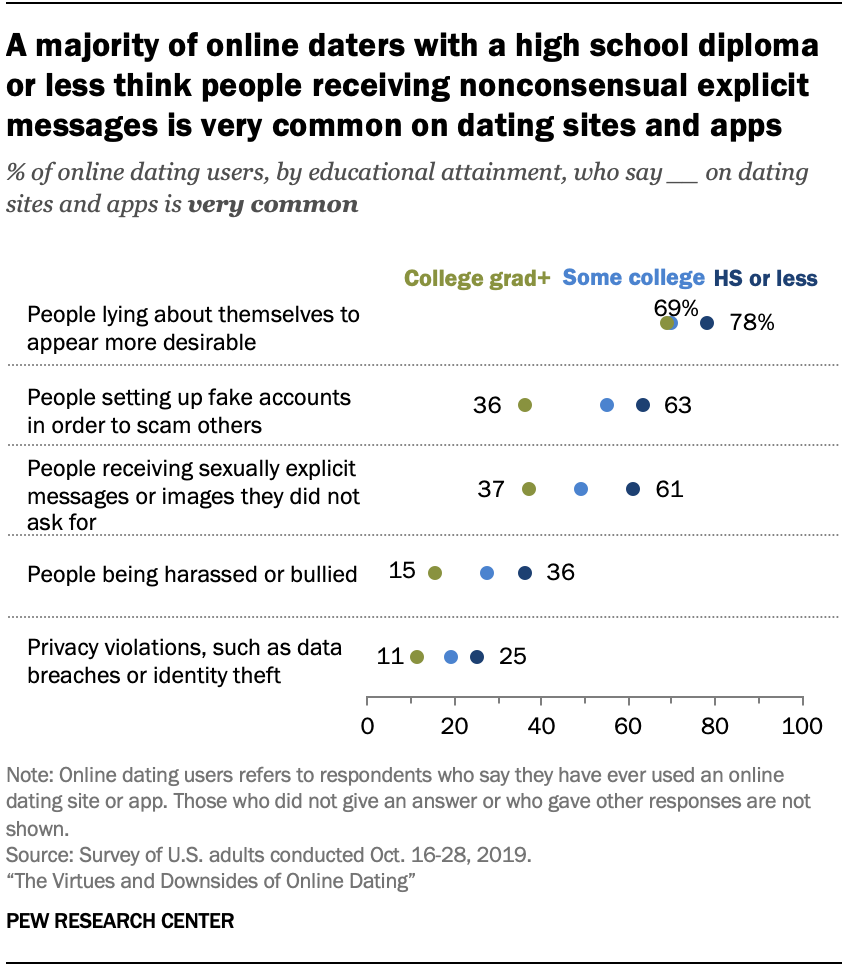 Views
about the pervasiveness of certain behaviors on dating platforms varies
substantially by educational attainment. For example, 61% of online
daters who have a high school diploma or less education say it is very
common for people to receive sexually explicit images or messages on
dating sites or apps, compared with 49% of those with some college
experience and 37% of those who have bachelor’s degree or more
education. At the same time, users with a high school education or less
are also more likely than those with a college degree to believe that
people setting up fake accounts for scams, people being harassed or
bullied, or privacy violations are a very common aspect of online
dating.
Views
about the pervasiveness of certain behaviors on dating platforms varies
substantially by educational attainment. For example, 61% of online
daters who have a high school diploma or less education say it is very
common for people to receive sexually explicit images or messages on
dating sites or apps, compared with 49% of those with some college
experience and 37% of those who have bachelor’s degree or more
education. At the same time, users with a high school education or less
are also more likely than those with a college degree to believe that
people setting up fake accounts for scams, people being harassed or
bullied, or privacy violations are a very common aspect of online
dating.
Men and women also hold somewhat differing views on the prevalence of these issues. Some 57% of women say that people setting up fake accounts in order to scam others is very common, compared with 44% of men who say this. And while about one-in-three female users (32%) think harassment is a very common occurrence on online dating platforms, that share falls to 19% among male users. Among online daters, women are also more likely than men to say it is very common for people on dating sites and apps to lie about themselves to appear more desirable (76% vs. 67%), receive sexually explicit messages or images they didn’t ask for (55% vs. 42%) or for privacy violations to occur (22% vs. 14%).
There also are large differences by age when respondents are asked about the prevalence of nonconsensual sexual messages: 56% of online dating users ages 18 to 49 say this is very common on these platforms, compared with just 27% of users ages 50 and older who say this.
This survey finds that online daters encounter a range of negative behaviors while using these platforms. Some 37% of online dating users say someone on a dating site or app has continued to contact them after they said they weren’t interested, while 28% say they have been called an offensive name while using these platforms. About one-in-ten users (9%) also say that someone on a dating site or app has threatened to physically harm them.
Other negative encounters are more sexualized: 35% of users say someone on a dating site or app has sent them a sexually explicit message or image they did not ask for.
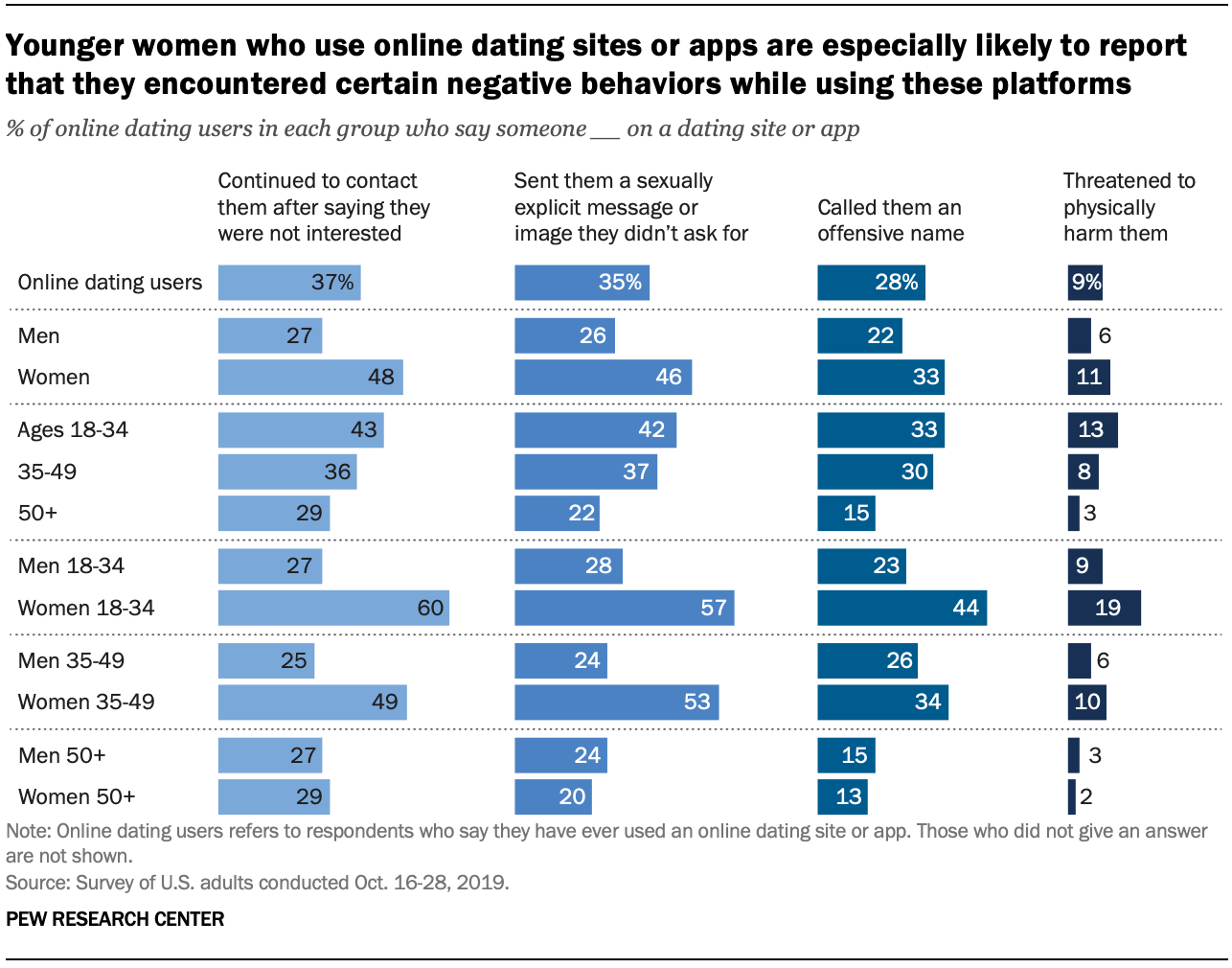 These unpleasant interactions are more prevalent among women than men
– with the largest gender gaps present among those who say they have
received unwanted contact or explicit messages. Some 48% of female users
say someone has continued to contact them after they said they were not
interested, while a similar share – 46% – report that they have been
sent a sexually explicit message or image they didn’t ask for. These
shares are considerably lower among male users (27% and 26%,
respectively). Similar gender gaps are present when online dating users
are asked about being called an offensive name or having someone
threaten to physically harm them.
These unpleasant interactions are more prevalent among women than men
– with the largest gender gaps present among those who say they have
received unwanted contact or explicit messages. Some 48% of female users
say someone has continued to contact them after they said they were not
interested, while a similar share – 46% – report that they have been
sent a sexually explicit message or image they didn’t ask for. These
shares are considerably lower among male users (27% and 26%,
respectively). Similar gender gaps are present when online dating users
are asked about being called an offensive name or having someone
threaten to physically harm them.
Younger women, in particular, stand out for how likely they are to encounter these behaviors on a dating platform. Six-in-ten female users ages 18 to 34 say someone through a dating site or app continued to contact them after they said they were not interested, while 57% say they have been sent a sexually explicit message or image that they did not ask for. At the same time, 44% of these younger female users say that someone has called them an offensive name via these platforms, while 19% report being physically threatened by another user. Each of these figures is substantially higher when compared with the experience of male online daters across age ranges, as well as that of female users ages 50 and up.
Women ages 35 to 49 who have online dated also are more likely than male users of the same age group – as well as men younger or older than them – to say someone has continued to contact them after they said they were not interested or sent them sexually explicit content on a dating platform.
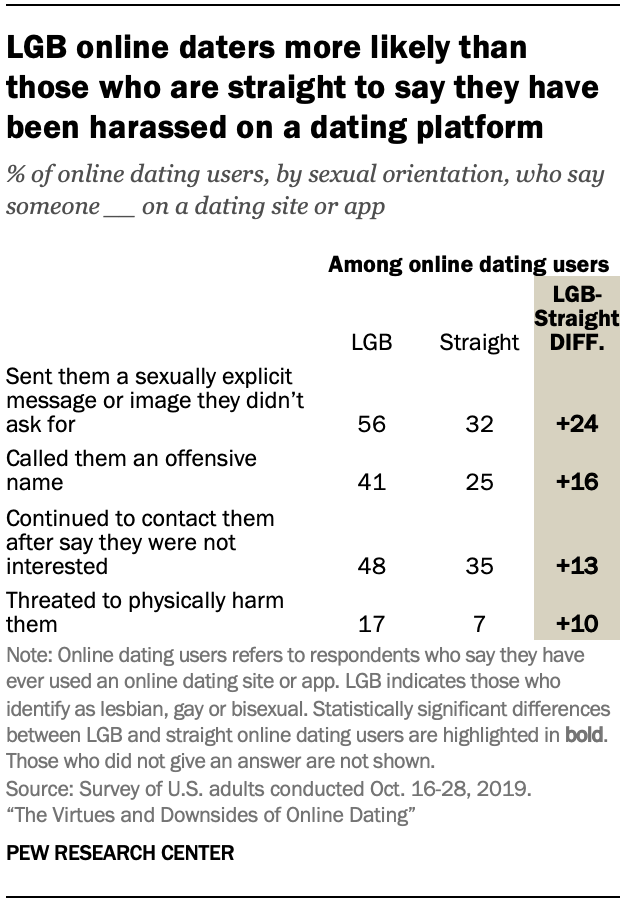 Whether
someone reports that they have been the target of these behaviors also
differs by sexual orientation. LGB users are more likely than straight
users to say someone on a dating site or app has sent them a sexually
explicit message or image they didn’t ask for (56% vs. 32%). LGB online
daters also are more likely than straight users to say they’ve faced
unwanted contact from someone after they said they were not interested,
been called an offensive name or been physical threatened by someone on a
dating site or app.
Whether
someone reports that they have been the target of these behaviors also
differs by sexual orientation. LGB users are more likely than straight
users to say someone on a dating site or app has sent them a sexually
explicit message or image they didn’t ask for (56% vs. 32%). LGB online
daters also are more likely than straight users to say they’ve faced
unwanted contact from someone after they said they were not interested,
been called an offensive name or been physical threatened by someone on a
dating site or app.
Overall, online daters are more likely to rate their experiences in positive rather than negative terms, and majorities of these users say that it is was easy to find others who shared their interests or wanted to meet in person. But users also describe a more troubling and frustrating side of online dating, including their own encounters with harassing behaviors on these platforms.
Roughly six-in-ten online daters say they have had an overall positive experience with these platforms
 Some
57% of Americans who have ever used an online dating site or app say
their own personal experiences with these platforms have been very (14%)
or somewhat (43%) positive. Smaller shares of users – though still
about four-in-ten – describe their time with online dating as at least
somewhat negative, including 9% who say it was a very negative.
Some
57% of Americans who have ever used an online dating site or app say
their own personal experiences with these platforms have been very (14%)
or somewhat (43%) positive. Smaller shares of users – though still
about four-in-ten – describe their time with online dating as at least
somewhat negative, including 9% who say it was a very negative.The way people assess their online dating experiences varies widely by socioeconomic factors. Fully 63% of online daters with a bachelor’s or advanced degree say their experience has been very or somewhat positive, compared with 47% among those who have a high school diploma or less. A similar pattern ties to users’ income: Online dating users whose annual family income is $75,000 or more a year are far more likely than those whose yearly family income falls below $30,000 to describe their experience as at least somewhat positive (70% vs. 44%).
By comparison, there are more modest differences by sexual orientation or age. LGB users are more likely than straight users to describe their own experience with dating sites or apps as very or somewhat positive (65% vs. 56%), while users ages 18 to 49 are more likely than those ages 50 and older to say their online dating experience has been at least somewhat positive (59% vs. 50%). By contrast, the way online daters rate their overall experience does not statistically vary by gender or race and ethnicity.
Current or recent users of these platforms say online dating leaves them feeling more frustrated than hopeful
Online dating often requires individuals to make themselves noticeable in a large pool of other daters who either accept or reject them based on quick assessments. For some, this fast-paced approach to dating may have a positive impact on their outlook and self-esteem, while others may feel more dispirited. To
better understand users’ experiences, the survey presented those who
have used online dating sites or apps within the past year with three
pairs of words and asked them to choose the sentiment that most closely
matched how they felt when using these platforms. Larger shares of
Americans who are currently using dating sites or apps or who have done
so in the past year say the experience left them feeling more frustrated
(45%) than hopeful (28%). Another 27% of these users say they felt
neither hopeful nor frustrated.
To
better understand users’ experiences, the survey presented those who
have used online dating sites or apps within the past year with three
pairs of words and asked them to choose the sentiment that most closely
matched how they felt when using these platforms. Larger shares of
Americans who are currently using dating sites or apps or who have done
so in the past year say the experience left them feeling more frustrated
(45%) than hopeful (28%). Another 27% of these users say they felt
neither hopeful nor frustrated.Other sentiments are more evenly balanced between positive and negative feelings. Some 35% of current or recent users say that in the past year online dating has made them feel more pessimistic, while 29% say these platforms left them feeling more optimistic. At the same time, 32% of current or recent online daters report that in the past year, dating sites or apps made them feel more confident, while 25% say dating sites or apps made them feel more insecure. Still, for each of these pairs of words, nearly four-in-ten or more of these users say that neither of the emotions offered reflects how they felt when using a dating site or app in the past year.
Online dating users across most demographic groups report similar emotions while using these platforms, but there are some differences by race and ethnicity. Among those who have used a dating site or app in the past year, white users are more likely than nonwhite users to say that these platforms have made them feel more frustrated (53% vs. 36%) or more pessimistic (40% vs. 29%).5
Majorities of online dating users found it easy to come across others who shared their interests or were looking for the same kind of relationship
 There have been numerous accounts
detailing some of the struggles of online dating – including the
difficulty that users may encounter when trying to find someone
compatible. Overall, online daters are more likely to say that finding
desirable or like-minded people was an easy rather than difficult
endeavor, but there are some groups who find these aspects of online
dating more daunting.
There have been numerous accounts
detailing some of the struggles of online dating – including the
difficulty that users may encounter when trying to find someone
compatible. Overall, online daters are more likely to say that finding
desirable or like-minded people was an easy rather than difficult
endeavor, but there are some groups who find these aspects of online
dating more daunting.Fully 71% of Americans who have ever used a dating site or app say it was at least somewhat easy to find people on these platforms that they were physically attracted to, including 28% who say that this was a very easy task for them. A majority of online daters also said it was very or somewhat easy to find people who shared their hobbies and interests (64%), seemed like someone they would want to meet in person (64%) or were looking for the same kind of relationship as them (61%).
 Online
daters’ assessments of how hard or easy it was to find compatible users
varies by gender. Women who have ever used a dating site or app are
more likely than men to say they have found it very or somewhat
difficult to find people that they were physical attracted to (36% vs.
21%) or seemed like someone they would want to meet in person (39% vs.
32%). On the other hand, 41% of male users say they found it at least
somewhat difficult to find people who shared their hobbies and
interests, compared with three-in-ten female users.
Online
daters’ assessments of how hard or easy it was to find compatible users
varies by gender. Women who have ever used a dating site or app are
more likely than men to say they have found it very or somewhat
difficult to find people that they were physical attracted to (36% vs.
21%) or seemed like someone they would want to meet in person (39% vs.
32%). On the other hand, 41% of male users say they found it at least
somewhat difficult to find people who shared their hobbies and
interests, compared with three-in-ten female users.There are some educational differences as well. Online daters who have a high school education or less, for example, are more likely than those with a bachelor’s or advanced degree to say that it was very or somewhat difficult to find people who were looking for the same kind of relationship as them (45% vs. 32%) or who shared their hobbies or interests (39% vs. 30%).
Men and women who have used online dating in the past five years have contrasting experiences with the amount of messages they received
When asked if they received too many, too few or just about the right amount of messages, 43% of Americans who have used an online dating site or app in the past five years say they did not receive enough messages, 40% think the amount was just about right, and fewer – 17% – say they received too many messages. But
there are stark gender differences in the amount of attention users
report receiving. Some 57% of men who have online dated in the past five
years report that they did not receive enough messages, while just 6%
state they received too many messages. By contrast, women who have used
dating sites or apps in this time period are five times as likely as men
to report they were sent too many messages (30% vs. 6%) and are far
less likely than men to say they did not receive enough messages (24%
express this view).
But
there are stark gender differences in the amount of attention users
report receiving. Some 57% of men who have online dated in the past five
years report that they did not receive enough messages, while just 6%
state they received too many messages. By contrast, women who have used
dating sites or apps in this time period are five times as likely as men
to report they were sent too many messages (30% vs. 6%) and are far
less likely than men to say they did not receive enough messages (24%
express this view).The survey also asked online daters about their experiences with getting messages from people they were interested in. Similarly, these users are more likely to report receiving too few rather than too many of these messages (54% vs. 13%). And while gender differences remain, they are less pronounced. For example, 61% of men who have online dated in the past five years say they did not receive enough messages from people they were interested in, compared with 44% of women who say this.
Online daters place a high level of importance on seeing other users’ photos, finding out the kind of relationship they’re interested in
Online dating allows users to quickly evaluate dozens of potential partners and scour profiles for all kinds of information – from the way someone looks to how they spend their free time and even their political leanings. But what are the most important things people look for as they scroll or swipe through profiles? Online
daters find it especially important to be able to view someone’s photo.
Fully 71% of users say it was very important to them that the profiles
they looked at included the other user’s photo.
Online
daters find it especially important to be able to view someone’s photo.
Fully 71% of users say it was very important to them that the profiles
they looked at included the other user’s photo.A majority of online dating users also felt it was necessary to gauge other users’ intentions: 63% say it was very important that the profiles they looked through included the type of relationship the other person was looking for.
Additionally, 45% of users say it was very important that profiles included whether the person had any children; 36% say this about hobbies and interests; and 25% feel this way about religious beliefs.
Smaller shares of users consider a person’s racial or ethnic background, occupation, height or political affiliation to be very important information to discover when looking through online dating profiles.
 Across
several measures, women are more likely than men to describe certain
information as essential to glean from someone’s profile. Roughly
seven-in-ten female users (72%) say that it was very important to them
that the profiles they looked at included the type of relationship the
person was looking for, while about half of male users say this (53%).
Among online daters, women also are more likely than men to say that it
was very important to them that the profiles included a person’s
religious beliefs (32% vs. 18%), occupation (27% vs. 8%) or height (22%
vs. 8%).
Across
several measures, women are more likely than men to describe certain
information as essential to glean from someone’s profile. Roughly
seven-in-ten female users (72%) say that it was very important to them
that the profiles they looked at included the type of relationship the
person was looking for, while about half of male users say this (53%).
Among online daters, women also are more likely than men to say that it
was very important to them that the profiles included a person’s
religious beliefs (32% vs. 18%), occupation (27% vs. 8%) or height (22%
vs. 8%).Other gender differences – such as the importance of users including in their profiles hobbies and interests, racial or ethnic background, or political affiliation – are more modest.
The level of importance that users place on certain content also varies by age. Online dating users ages 50 and older are more likely than users ages 18 to 49 to say that it is very important that the profiles they looked at included the person’s race or ethnicity (26% vs. 16%) or their political affiliation (21% vs. 12%). Younger users, on the other hand, are more likely than older users to say that it was very important to them that profiles they came across included whether the person had children (48% vs. 37%).
Users of dating sites or apps generally believe embellishment is a very common part of the online dating experience
Even as users of dating sites and apps generally rate their overall experiences positively, they also believe that certain negative behaviors are especially prevalent on these platforms. Indeed,
a majority of users characterize lying as a prevalent feature of the
online dating environment. Fully 71% of adults who have used an online
dating site or app say it is very common for people on these platforms
to lie about themselves to appear more desirable.
Indeed,
a majority of users characterize lying as a prevalent feature of the
online dating environment. Fully 71% of adults who have used an online
dating site or app say it is very common for people on these platforms
to lie about themselves to appear more desirable.Smaller shares – though still about half of all users – believe that it is very common for people on dating sites and apps to set up fake accounts in order to scam others (50%) or for people to receive sexually explicit messages or images they did not ask for (48%). Fewer users believe that people being harassed or bullied (25%) or data privacy violations (18%) are very common occurrences on online dating sites or apps.
 Views
about the pervasiveness of certain behaviors on dating platforms varies
substantially by educational attainment. For example, 61% of online
daters who have a high school diploma or less education say it is very
common for people to receive sexually explicit images or messages on
dating sites or apps, compared with 49% of those with some college
experience and 37% of those who have bachelor’s degree or more
education. At the same time, users with a high school education or less
are also more likely than those with a college degree to believe that
people setting up fake accounts for scams, people being harassed or
bullied, or privacy violations are a very common aspect of online
dating.
Views
about the pervasiveness of certain behaviors on dating platforms varies
substantially by educational attainment. For example, 61% of online
daters who have a high school diploma or less education say it is very
common for people to receive sexually explicit images or messages on
dating sites or apps, compared with 49% of those with some college
experience and 37% of those who have bachelor’s degree or more
education. At the same time, users with a high school education or less
are also more likely than those with a college degree to believe that
people setting up fake accounts for scams, people being harassed or
bullied, or privacy violations are a very common aspect of online
dating.Men and women also hold somewhat differing views on the prevalence of these issues. Some 57% of women say that people setting up fake accounts in order to scam others is very common, compared with 44% of men who say this. And while about one-in-three female users (32%) think harassment is a very common occurrence on online dating platforms, that share falls to 19% among male users. Among online daters, women are also more likely than men to say it is very common for people on dating sites and apps to lie about themselves to appear more desirable (76% vs. 67%), receive sexually explicit messages or images they didn’t ask for (55% vs. 42%) or for privacy violations to occur (22% vs. 14%).
There also are large differences by age when respondents are asked about the prevalence of nonconsensual sexual messages: 56% of online dating users ages 18 to 49 say this is very common on these platforms, compared with just 27% of users ages 50 and older who say this.
Younger women are especially likely to be the target of harassing behaviors when using these platforms
Online harassment has become a regular feature of life on the internet, from social media sites to comments sections – and dating platforms.This survey finds that online daters encounter a range of negative behaviors while using these platforms. Some 37% of online dating users say someone on a dating site or app has continued to contact them after they said they weren’t interested, while 28% say they have been called an offensive name while using these platforms. About one-in-ten users (9%) also say that someone on a dating site or app has threatened to physically harm them.
Other negative encounters are more sexualized: 35% of users say someone on a dating site or app has sent them a sexually explicit message or image they did not ask for.
 These unpleasant interactions are more prevalent among women than men
– with the largest gender gaps present among those who say they have
received unwanted contact or explicit messages. Some 48% of female users
say someone has continued to contact them after they said they were not
interested, while a similar share – 46% – report that they have been
sent a sexually explicit message or image they didn’t ask for. These
shares are considerably lower among male users (27% and 26%,
respectively). Similar gender gaps are present when online dating users
are asked about being called an offensive name or having someone
threaten to physically harm them.
These unpleasant interactions are more prevalent among women than men
– with the largest gender gaps present among those who say they have
received unwanted contact or explicit messages. Some 48% of female users
say someone has continued to contact them after they said they were not
interested, while a similar share – 46% – report that they have been
sent a sexually explicit message or image they didn’t ask for. These
shares are considerably lower among male users (27% and 26%,
respectively). Similar gender gaps are present when online dating users
are asked about being called an offensive name or having someone
threaten to physically harm them.Younger women, in particular, stand out for how likely they are to encounter these behaviors on a dating platform. Six-in-ten female users ages 18 to 34 say someone through a dating site or app continued to contact them after they said they were not interested, while 57% say they have been sent a sexually explicit message or image that they did not ask for. At the same time, 44% of these younger female users say that someone has called them an offensive name via these platforms, while 19% report being physically threatened by another user. Each of these figures is substantially higher when compared with the experience of male online daters across age ranges, as well as that of female users ages 50 and up.
Women ages 35 to 49 who have online dated also are more likely than male users of the same age group – as well as men younger or older than them – to say someone has continued to contact them after they said they were not interested or sent them sexually explicit content on a dating platform.
 Whether
someone reports that they have been the target of these behaviors also
differs by sexual orientation. LGB users are more likely than straight
users to say someone on a dating site or app has sent them a sexually
explicit message or image they didn’t ask for (56% vs. 32%). LGB online
daters also are more likely than straight users to say they’ve faced
unwanted contact from someone after they said they were not interested,
been called an offensive name or been physical threatened by someone on a
dating site or app.
Whether
someone reports that they have been the target of these behaviors also
differs by sexual orientation. LGB users are more likely than straight
users to say someone on a dating site or app has sent them a sexually
explicit message or image they didn’t ask for (56% vs. 32%). LGB online
daters also are more likely than straight users to say they’ve faced
unwanted contact from someone after they said they were not interested,
been called an offensive name or been physical threatened by someone on a
dating site or app.Americans’ opinions about the online dating environment
Online dating platforms have been scrutinized at times for the way they have contributed to dating culture and its safety, as well as how successful they are at finding people a suitable match. There are a slew of both troubling and love stories involving online dating.
This chapter explores how all Americans – not just those who have online dated – feel about the broader landscape and impact of online dating. To begin, Americans are more likely to describe online dating as having a neutral impact on dating and relationships, rather than a mostly positive or negative one. And when asked to share their views about the success of relationships that begin through online dating, just over half of U.S. adults agree that these relationships are just as successful as those that began offline.
Still, views about online dating do vary across demographic groups, as well as by people’s own personal experience with using these sites or apps. At the same time, there are some lingering concerns about the danger of meeting someone through a dating site or app. Americans are somewhat divided on whether these platforms are a safe way to meet people.
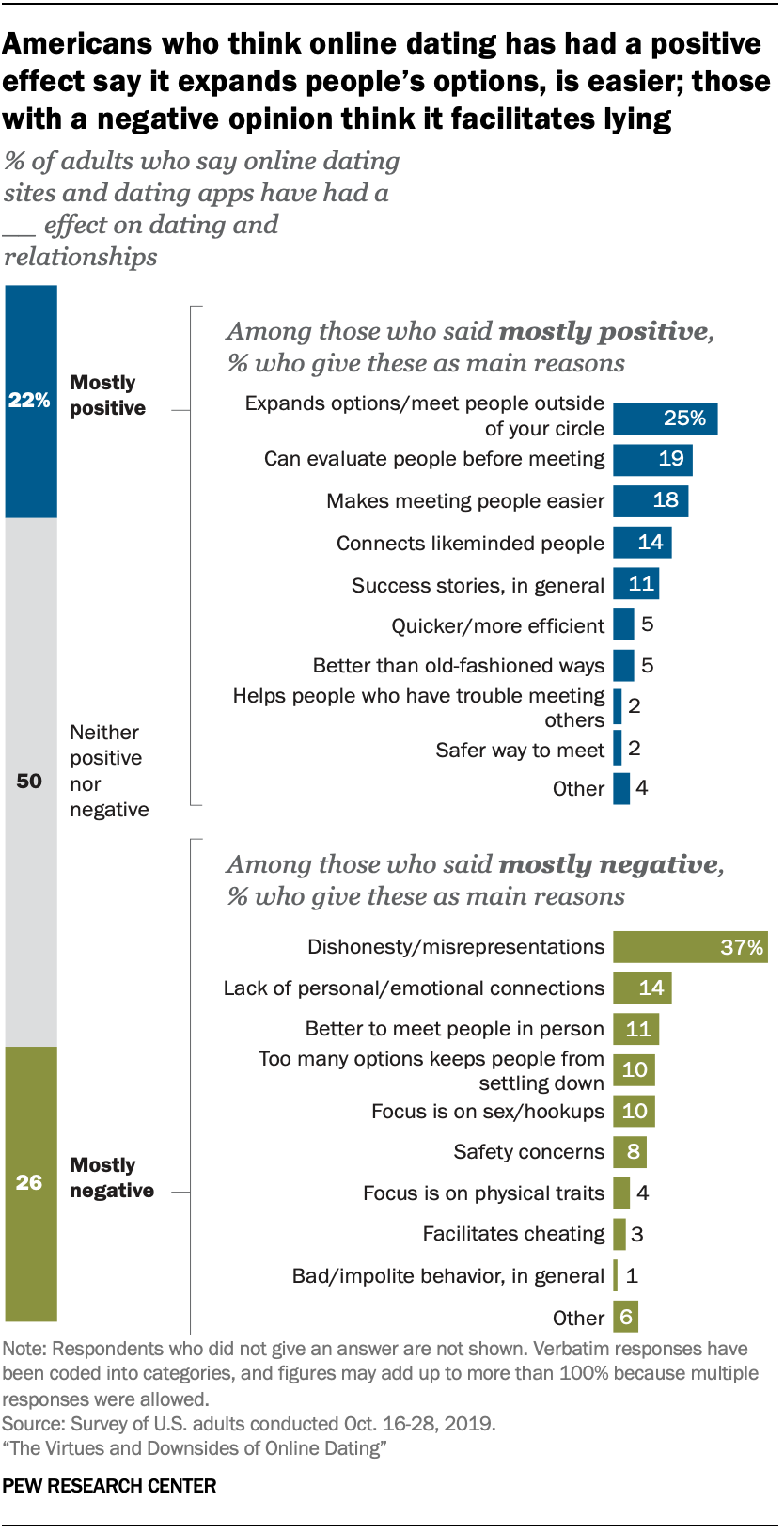 When
asked to share their views on the type of effect dating sites and apps
have had on dating and relationships, 50% of Americans believe their
effect has been neither positive nor negative. Meanwhile, 26% say online
dating has had a mostly negative effect on dating and relationships,
while 22% describe its effect as mostly positive.
When
asked to share their views on the type of effect dating sites and apps
have had on dating and relationships, 50% of Americans believe their
effect has been neither positive nor negative. Meanwhile, 26% say online
dating has had a mostly negative effect on dating and relationships,
while 22% describe its effect as mostly positive.
Across demographic groups, larger shares of Americans feel as if online dating has had neither a positive nor negative effect on dating and relationships, but personal experience with online dating also is associated with more positive views of its impact. Some 29% of online dating users view its effect on dating and relationships as mostly positive, compared with 21% of those who never used a dating site or app.
At the same time, 30% of adults with at least a bachelor’s degree say that dating sites and apps have a mostly positive effect on dating relationships, compared with 18% of those with a high school education or less. These educational differences are present regardless of online dating use.
Among respondents who say dating sites and apps have had a mostly positive effect, 25% say it is because they have helped expand people’s dating pool. Many of these responses emphasize how online dating has made it easier to meet people outside of one’s normal social circle, thereby expanding their options:
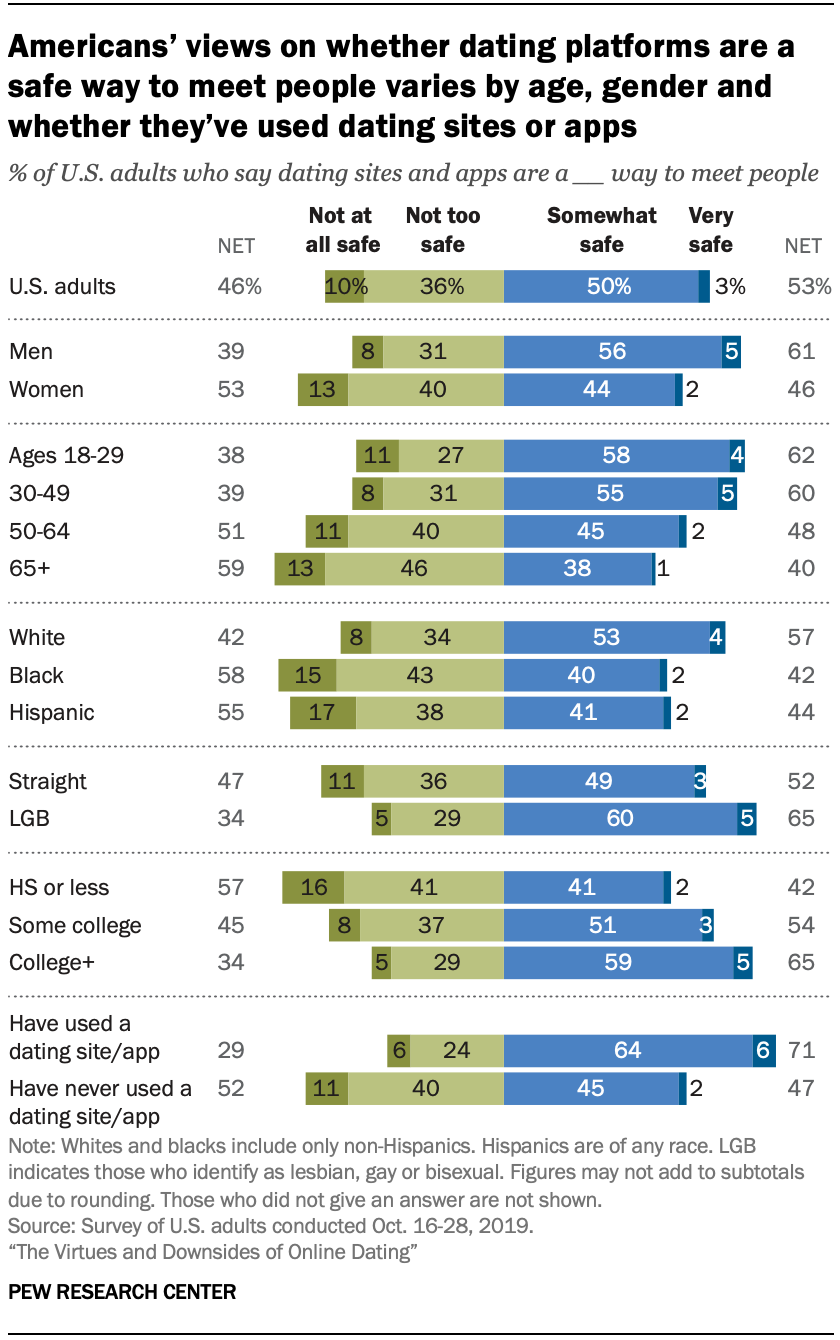 Overall,
Americans are somewhat divided on whether online dating is a safe way
to meet someone. Roughly half of the public says that dating sites and
apps are a very (3%) or somewhat (50%) safe way to meet people. Still,
perceptions that online dating is a dangerous way to meet someone are
fairly common. Some 46% of Americans believe meeting someone through
online dating is not safe, including one-in-ten who say it is not at all
a safe way to meet people.
Overall,
Americans are somewhat divided on whether online dating is a safe way
to meet someone. Roughly half of the public says that dating sites and
apps are a very (3%) or somewhat (50%) safe way to meet people. Still,
perceptions that online dating is a dangerous way to meet someone are
fairly common. Some 46% of Americans believe meeting someone through
online dating is not safe, including one-in-ten who say it is not at all
a safe way to meet people.
Public perceptions about the safety of online dating vary substantially by personal experience. A majority of Americans who have ever used a dating site or app (71%) see it as a very or somewhat safe way to meet someone, compared with 47% of those who have never used these platforms.
There are other groups who also express concerns about the safety of online dating. Women are far more likely than men to say dating sites and apps are not a safe way meet to people (53% vs. 39%). And while 39% of adults under the age of 50 view online dating as unsafe, that share is 54% among those ages 50 and older.
Additionally, 57% of adults with a high school education or less think meeting someone through a dating platform is not safe, compared with just about a third of those with a bachelor’s or advanced degree (34%). There also are differences in views about online dating safety by race and ethnicity, as well as, by sexual orientation.
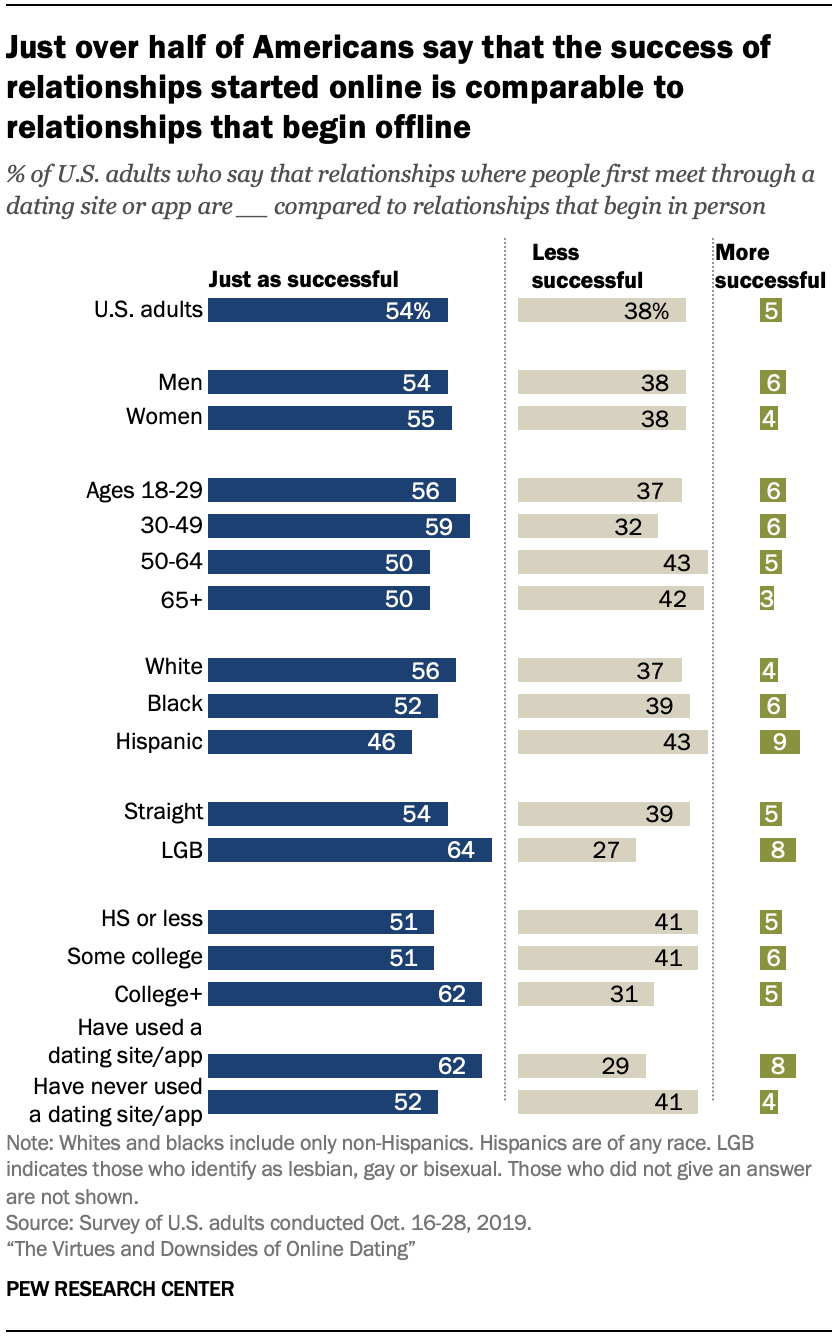 One of the central debates
that emerged with the rise of online dating is whether courtships that
begin online can be as successful and long-lasting as those forged in
person.
One of the central debates
that emerged with the rise of online dating is whether courtships that
begin online can be as successful and long-lasting as those forged in
person.
When asked whether relationships where people first meet through an online dating site or app are generally more successful, less successful or just as successful as those that begin in person, 54% of Americans agree that these relationships are just as successful. Smaller shares – though still around four-in-ten (38%) – categorize these relationships as less successful, while relatively few Americans (5%) say relationships in which people first met through online dating are more successful than those that begin in person.
Larger shares of most groups believe relationships that start through dating sites or apps are just as successful as those that begin in person, but there are some Americans who are more skeptical of digitally forged relationships.
Again, views about online dating differ between those who have used these platforms and those who have not. Roughly four-in-ten Americans who have never online dated (41%) believe relationships that start off through dating platforms are less successful than those that begin in person, compared with 29% of those who have used a dating site or app.
Americans ages 50 and up are more likely than those under the age of 50 to say that relationships that first began through a dating site or app are less successful than relationships that started in person (43% vs. 34%). And adults who have a high school education or less are more likely than those with a bachelor’s or advanced degree to believe that these types of relationships are less successful when compared with those that begin in person (41% vs. 31%). There also are differences by sexual orientation. Some 39% of straight adults feel that relationships that began through online dating are less successful, while smaller shares of LGB adults (27%) hold this view.
This pattern is true even among those who have online dated. Among those who have used a dating site or app, older or straight adults are more likely than those who are younger or LGB to say relationships that start through dating sites and apps are less successful than those that start in person.
Online dating users who have married or been in a committed relationship with someone they met online are more likely than those who haven’t to say that these platforms have had a mostly positive effect on dating and relationships overall (37% vs. 23%), or to view online dating as at least a somewhat safe way to meet people (79% vs. 66%). Online daters who have had success in finding committed relationships online also are more likely than those who haven’t to say relationships started through dating sites or apps are just as successful as those started offline (67% vs. 58%).
Users who had at least a somewhat positive experience overall using these platforms also are more likely to view them as having had a positive effect on dating and relationships, compared with those who have had a very or somewhat negative overall experience (39% vs. 14%). Differences in perceived safety also are present. Fully 82% of online daters who had a positive experience with dating sites or apps believe these platforms are a safe way to meet people, compared with 55% among those who categorize their overall online dating experience as negative.
Additionally, opinions about online dating vary by users’ own encounters with harassment on these platforms. Online daters who have experienced some form of harassment measured in this survey are more likely to say that online dating platforms have had a mostly negative effect on dating and relationships, compared with those who have not experienced harassment (30% vs. 20%). And while majorities of online daters, regardless of their experience with harassment, think of these platforms as a safe way to meet someone, those who personally have faced these negative interactions (66%) are less likely than those who haven’t to describe it as at least somewhat safe (77%).
This chapter explores how all Americans – not just those who have online dated – feel about the broader landscape and impact of online dating. To begin, Americans are more likely to describe online dating as having a neutral impact on dating and relationships, rather than a mostly positive or negative one. And when asked to share their views about the success of relationships that begin through online dating, just over half of U.S. adults agree that these relationships are just as successful as those that began offline.
Still, views about online dating do vary across demographic groups, as well as by people’s own personal experience with using these sites or apps. At the same time, there are some lingering concerns about the danger of meeting someone through a dating site or app. Americans are somewhat divided on whether these platforms are a safe way to meet people.
Half of Americans believe that online dating has had neither a positive nor negative effect on dating and relationships
 When
asked to share their views on the type of effect dating sites and apps
have had on dating and relationships, 50% of Americans believe their
effect has been neither positive nor negative. Meanwhile, 26% say online
dating has had a mostly negative effect on dating and relationships,
while 22% describe its effect as mostly positive.
When
asked to share their views on the type of effect dating sites and apps
have had on dating and relationships, 50% of Americans believe their
effect has been neither positive nor negative. Meanwhile, 26% say online
dating has had a mostly negative effect on dating and relationships,
while 22% describe its effect as mostly positive.Across demographic groups, larger shares of Americans feel as if online dating has had neither a positive nor negative effect on dating and relationships, but personal experience with online dating also is associated with more positive views of its impact. Some 29% of online dating users view its effect on dating and relationships as mostly positive, compared with 21% of those who never used a dating site or app.
At the same time, 30% of adults with at least a bachelor’s degree say that dating sites and apps have a mostly positive effect on dating relationships, compared with 18% of those with a high school education or less. These educational differences are present regardless of online dating use.
Americans cite a number of reasons – ranging from expanding options to success stories – as reasons these platforms have been a good thing for dating and relationships
The survey also asked an open-ended question to give respondents a chance to explain, in their own words, why they feel as if dating sites and apps have had a mostly positive or mostly negative effect on dating and relationships.Among respondents who say dating sites and apps have had a mostly positive effect, 25% say it is because they have helped expand people’s dating pool. Many of these responses emphasize how online dating has made it easier to meet people outside of one’s normal social circle, thereby expanding their options:
“They allow people who wouldn’t have
ever really crossed paths in person easier access to that possible ‘one’
that they otherwise wouldn’t have ever met.” (Woman, age 36)
“It widens the pool of available persons.” (Woman, age 64)
Others in this group cite the ability to
evaluate people before meeting them in person (19%) or that it is
generally an easier way to meet people who also are interested in dating
(18%).
“You read people’s profiles and know
what they are all about before reaching out to them. Cheaper than going
on a date to find out the hard way.” (Man, age 43)
“Easy to meet people. Easy to break
the ice. Easy to size up people to see if you would like to really date
them.” (Woman, age 28)
Some 14% of these respondents also express
that these platforms can connect people who are likeminded or have
mutual interests, while 11% offer up success stories as a reason online
dating has had a mostly positive impact on dating.
“It’s easier to find someone who
shares your interest and values. Easier to identify what you have in
common before you decide to pursue spending time together.” (Man, age
54)
“We have known untold numbers of
now-married couples who met online. … It does shrink the world to help
you meet wonderful people.” (Woman, age 75)
Relatively small shares argue that online dating has had a mostly
positive effect because it is a more efficient way of meeting people, is
a better alternative to more traditional ways of meeting, helps people
who have trouble meeting others or is a safer way of meeting people.Americans who believe online dating has had a mostly negative effect on dating and relationships are especially likely to stress issues related to dishonesty
There is a stronger consensus among respondents who believe dating sites and apps have had a mostly negative effect. By far the most common response (given by 37% of these respondents) mentions that these platforms are a venue for various forms of dishonesty – ranging from people embellishing the truth to outright scams.
“You only know what they want you to know. They lie about themselves to make themselves look good.” (Man, age 58)
“People give a description of who they
want to be and not always how they really are. You can’t depend on
everyone being honest about who they are on both the positive and
negative sides.” (Woman, age 40)
“I found there are a lot of scammers on dating sites trying to take advantage of others.” (Woman, age 59)
Another 14% in this group mention that online dating has made courtship more impersonal and devoid of meaningful communication.
“People don’t act like themselves
online. No one is actually getting to really know each other.
Communication is flawed from the beginning.” (Woman, age 33)
“There is a constant influx of ‘new
inventory.’ It’s made dating more of a shopping activity (consumerism)
than an interpersonal experience (emotional). The ‘swipe right’
mentality starts to affect us in everyday life.” (Man, age 56)
And additional 11% say the traditional ways of meeting were better
and online dating has prevented people from connecting in the physical
world. Overall, people who answer in this theme feel that online dating
is generally just a bad way to meet people:
“Profiling isn’t romantic. The slower
process of meeting someone, the chase, maybe the game and the
face-to-face learning about each other makes for deeper and lasting
feelings.” (Man, age 72)
“The old-fashioned way of meeting
people in person or getting introduced through friends seems more
individualized.” (Woman, age 30)
Respondents also offer other reasons they believe online dating has
negatively affected dating, including that it keeps people from settling
down because there are too many options (10% say this), while another
10% criticize these platforms for encouraging casual relationships and
hookups. Another 8% in this group attribute their negative views of
online dating to safety concerns.
“It’s hard to work on a relationship
or give a partner another chance when sites/apps are constantly
promoting the message that you are surrounded by wonderful singles all
the time. It makes you believe that there is always a better or easier
option available.” (Woman, age 27)
“Those sites and apps are used more
for hookups nowadays and the people on there are not seriously looking
for a committed relationship.” (Woman, age 33)
“I find the whole thing just extremely
odd. I think that it is actually rather dangerous to meet complete
strangers that way. It’s too easy for serial killers, psychos, thieves
and people that are up to no good to find new victims that way.” (Woman,
age 47)
About half of Americans think online dating is a safe way to meet people – but this varies substantially by age, gender and personal experiences with dating sites and apps
 Overall,
Americans are somewhat divided on whether online dating is a safe way
to meet someone. Roughly half of the public says that dating sites and
apps are a very (3%) or somewhat (50%) safe way to meet people. Still,
perceptions that online dating is a dangerous way to meet someone are
fairly common. Some 46% of Americans believe meeting someone through
online dating is not safe, including one-in-ten who say it is not at all
a safe way to meet people.
Overall,
Americans are somewhat divided on whether online dating is a safe way
to meet someone. Roughly half of the public says that dating sites and
apps are a very (3%) or somewhat (50%) safe way to meet people. Still,
perceptions that online dating is a dangerous way to meet someone are
fairly common. Some 46% of Americans believe meeting someone through
online dating is not safe, including one-in-ten who say it is not at all
a safe way to meet people.Public perceptions about the safety of online dating vary substantially by personal experience. A majority of Americans who have ever used a dating site or app (71%) see it as a very or somewhat safe way to meet someone, compared with 47% of those who have never used these platforms.
There are other groups who also express concerns about the safety of online dating. Women are far more likely than men to say dating sites and apps are not a safe way meet to people (53% vs. 39%). And while 39% of adults under the age of 50 view online dating as unsafe, that share is 54% among those ages 50 and older.
Additionally, 57% of adults with a high school education or less think meeting someone through a dating platform is not safe, compared with just about a third of those with a bachelor’s or advanced degree (34%). There also are differences in views about online dating safety by race and ethnicity, as well as, by sexual orientation.
54% of the public says relationships where people first meet through a dating site or app are just as successful as those that begin in person
 One of the central debates
that emerged with the rise of online dating is whether courtships that
begin online can be as successful and long-lasting as those forged in
person.
One of the central debates
that emerged with the rise of online dating is whether courtships that
begin online can be as successful and long-lasting as those forged in
person.When asked whether relationships where people first meet through an online dating site or app are generally more successful, less successful or just as successful as those that begin in person, 54% of Americans agree that these relationships are just as successful. Smaller shares – though still around four-in-ten (38%) – categorize these relationships as less successful, while relatively few Americans (5%) say relationships in which people first met through online dating are more successful than those that begin in person.
Larger shares of most groups believe relationships that start through dating sites or apps are just as successful as those that begin in person, but there are some Americans who are more skeptical of digitally forged relationships.
Again, views about online dating differ between those who have used these platforms and those who have not. Roughly four-in-ten Americans who have never online dated (41%) believe relationships that start off through dating platforms are less successful than those that begin in person, compared with 29% of those who have used a dating site or app.
Americans ages 50 and up are more likely than those under the age of 50 to say that relationships that first began through a dating site or app are less successful than relationships that started in person (43% vs. 34%). And adults who have a high school education or less are more likely than those with a bachelor’s or advanced degree to believe that these types of relationships are less successful when compared with those that begin in person (41% vs. 31%). There also are differences by sexual orientation. Some 39% of straight adults feel that relationships that began through online dating are less successful, while smaller shares of LGB adults (27%) hold this view.
This pattern is true even among those who have online dated. Among those who have used a dating site or app, older or straight adults are more likely than those who are younger or LGB to say relationships that start through dating sites and apps are less successful than those that start in person.
Americans who have had more success with online dating tend to view it more positively
Across several measures, online daters who have found a committed partner through these dating sites or apps tend to view these platforms in a more positive light. The same is true of how they rate their overall experience, as well as whether they’ve experienced some form of harassment while using these platforms.Online dating users who have married or been in a committed relationship with someone they met online are more likely than those who haven’t to say that these platforms have had a mostly positive effect on dating and relationships overall (37% vs. 23%), or to view online dating as at least a somewhat safe way to meet people (79% vs. 66%). Online daters who have had success in finding committed relationships online also are more likely than those who haven’t to say relationships started through dating sites or apps are just as successful as those started offline (67% vs. 58%).
Users who had at least a somewhat positive experience overall using these platforms also are more likely to view them as having had a positive effect on dating and relationships, compared with those who have had a very or somewhat negative overall experience (39% vs. 14%). Differences in perceived safety also are present. Fully 82% of online daters who had a positive experience with dating sites or apps believe these platforms are a safe way to meet people, compared with 55% among those who categorize their overall online dating experience as negative.
Additionally, opinions about online dating vary by users’ own encounters with harassment on these platforms. Online daters who have experienced some form of harassment measured in this survey are more likely to say that online dating platforms have had a mostly negative effect on dating and relationships, compared with those who have not experienced harassment (30% vs. 20%). And while majorities of online daters, regardless of their experience with harassment, think of these platforms as a safe way to meet someone, those who personally have faced these negative interactions (66%) are less likely than those who haven’t to describe it as at least somewhat safe (77%).


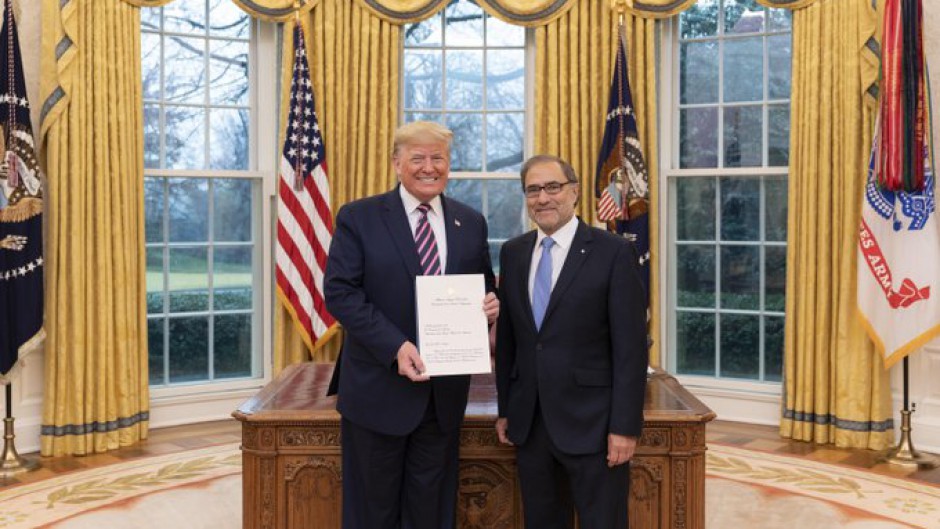 Trump recibió a Argüello en la Casa Blanca.
Trump recibió a Argüello en la Casa Blanca. 



